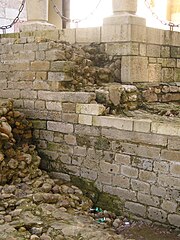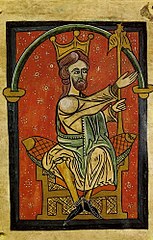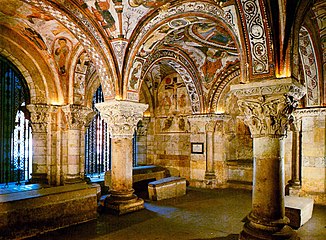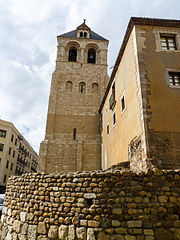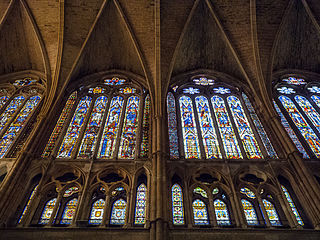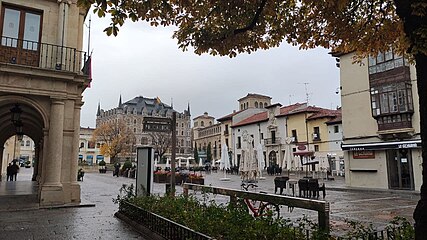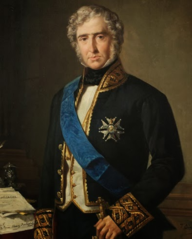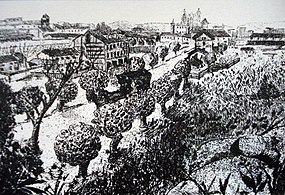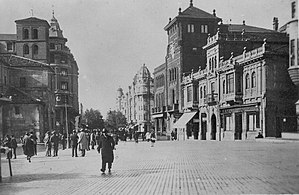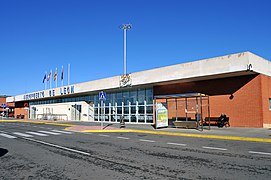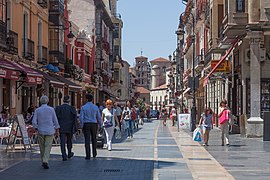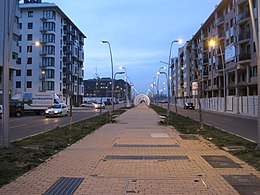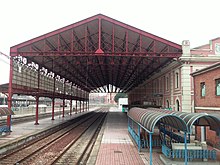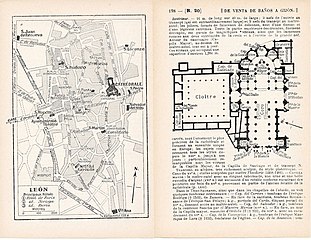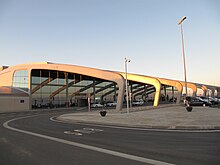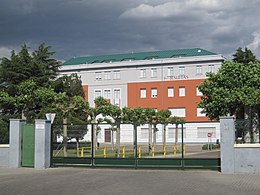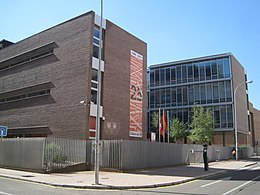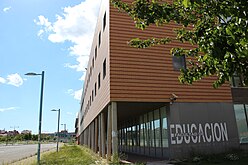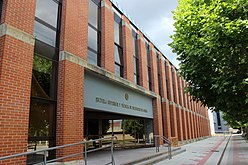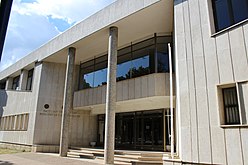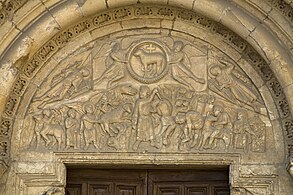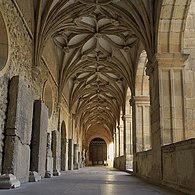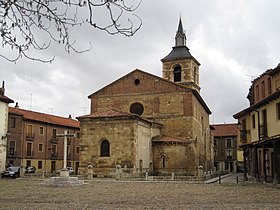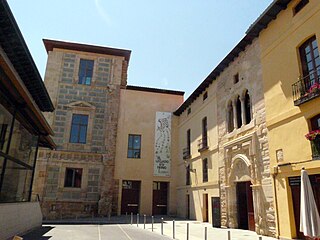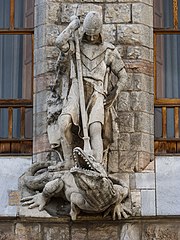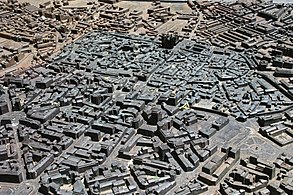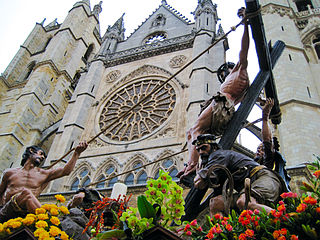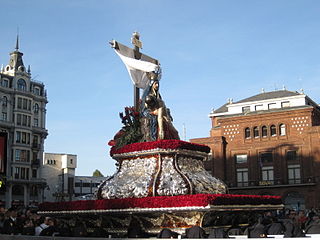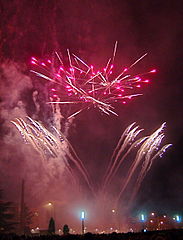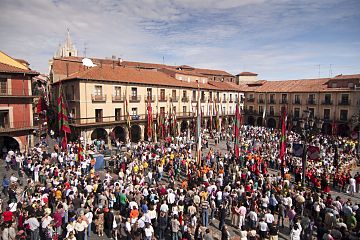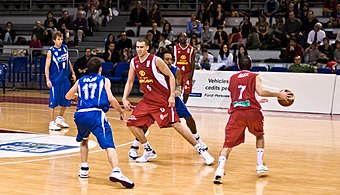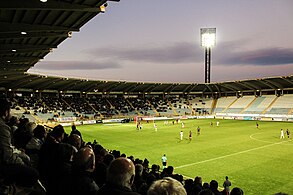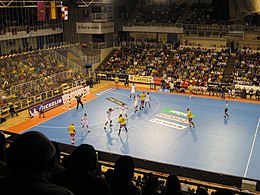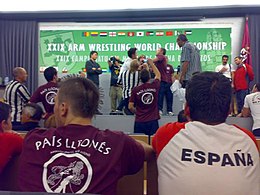Leon (Spain)
León (in Leonese, Llión) is a municipality and Spanish city in the northwest of the Iberian Peninsula, capital of the homonymous province, in the autonomous community of Castile and Leon. In January 2021, León had &&&&&&&&&0122051.&&&&&0122,051 inhabitants spread over an area of 39.03 km², and a metropolitan area of 203,191 inhabitants according to the map of functional areas of the Junta de Castilla y León (other projects give different figures) distributed in fifteen municipalities.
Created as a Roman military camp for the Legio VI Victrix around 29 B.C. C., its character as a camp city was consolidated with the definitive settlement of the Legio VII Gemina from the year 74. After its partial depopulation due to the Muslim conquest of the peninsula, León received a new impulse as part of the Kingdom of Asturias. In 910 one of its most outstanding historical stages began when it became head of the Kingdom of León, actively participating in the Reconquest against the Muslims, becoming one of the fundamental kingdoms in the configuration of the Kingdom of Spain. The city housed the first Courts in the history of Europe in 1188, under the reign of Alfonso IX, thanks to which in 2011 it was proclaimed by UNESCO and by the Junta de Castilla y León as the Cradle of Parliamentarianism. Half the city ceased to have the importance of yesteryear, partly due to the loss of its independence after the integration of the Leonese kingdom into the Castilian Crown, definitive since 1301.
Plunged into a period of stagnation during the Modern Age, in the War of Independence it was one of the first cities to rise up in all of Spain, and years after the end of it, in 1833, it would acquire the rank of provincial capital. The arrival of the XX century brought with it the Ensanche Plan, which increased the urban expansion that it had been experiencing since the end of the XIX, when the city became an important communication hub in the northwest due to the rise of coal mining and the arrival of the railway.
Its historical and monumental heritage, as well as various celebrations that take place throughout the year, among which Holy Week stands out, and its situation as an obligatory step on the Camino de Santiago, considered a World Heritage Site by UNESCO, make it a receiving city for national and international tourism. Among its most representative monuments are the Cathedral of Santa María de Regla, the best example of French-style classical Gothic in Spain, the Basilica of San Isidoro, one of the most important Romanesque churches in Spain, tomb of the medieval kings of León and considered as the Sistine Chapel of Romanesque art, the Monastery of San Marcos, the first example of Spanish Plateresque and Renaissance architecture, the Palace of Los Guzmanes, the Palace of the Counts of Luna, the Church of the Market or of Camino la Antigua, the Palat del Rey church, the Casa de las Carnicerías and the Casa Botines, in modernist style and designed by the brilliant Catalan architect Antoni Gaudí; all of them declared Assets of Cultural Interest. An outstanding example of modern architecture, and one of the city's museums, is the MUSAC, by Mansilla + Tuñón Arquitectos.
The University of León, founded in 1979 as a spin-off from the University of Oviedo, had 10,206 students in the 2019-2020 academic year; it is based in the city and is cataloged, based on criteria such as university demand, human resources or study plans, as the 2nd university in Castilla y León, after the University of Salamanca, and the 30th in Spain. Since May 4, 2010, the city is home to the second headquarters of the University of Washington in Europe, after its headquarters in Rome, with capacity for 500 students interested in learning Spanish. Since 2011 the city also has a headquarters of the Confucius Institute.
Toponymy
The origin of the city's name comes from the Latin word legio in its accusative case form legionem, which refers to the Legio VII Gemina or Seventh Twin Legion who founded the city in its current location. This thesis, commonly accepted, favors the cult name "legionense" to refer to the inhabitants of the city, which coexists with the popular "leonese". The evolution of Legione(m) (with soft g pronunciation) to León went through intermediate stages as Leyone or Leyón.
Physical geography
Location
The city of León is located on a fluvial terrace at the confluence of the Bernesga and Torío rivers, at an altitude of 840 m a.s.l. no. m.. Located approximately in the center of the province, it is located in a strategic place in the northwest of the peninsula, since it is an obligatory step to go to Galicia and Asturias.
Its municipal area limits to the north with Sariegos and Villaquilambre, to the east with Valdefresno, to the south with Santovenia de la Valdoncina, Onzonilla and Villaturiel, and to the west with San Andrés del Rabanedo and Valverde de la Virgen. The territory of the municipal term is represented on sheet 161 of the National Topographic Map.
| Northwest: Sariegos | North: Villaquilambre | Northeast: Villaquilambre |
| West: San Andrés del Rabanedo and Valverde de la Virgen |  | This: Valdefresno |
| Southwest: Santovenia de la Valdoncina | South: Onzonilla | Sureste: Villaturiel |
Orography
Located at the transition from the Páramo Leonés to the Cantabrian mountain range, its location at the confluence of two rivers means that the capital of Leon sits in a predominantly flat area, although as it moves away from the urban center the terrain rises, meeting to the north with Mount San Isidro and to the east with the heights on which Golpejar de la Sobarriba is located. In the municipal area are the geodesic vertices of Valenciano, at an altitude of 938 m a.s.l. no. m., and San Isidro, at an altitude of 939 meters. In the center of the city it is located at an altitude of 837 meters, while the altitude of the municipality varies from 800 meters in the last section in the town of Bernesga River up to 944 meters in the north of the municipality.
Hydrography
León is bathed by the rivers Bernesga, which runs through the city to the west, and the Torío, which delimits it to the east, placing most of the urban center between the two channels. As they pass through the city, they are channeled and suitable for walkers, with gardens and pedestrian walkways. The confluence of both is located at the height of the La Lastra industrial estate, where the Torío pours its waters into the Bernesga.
On the river, and in the center of the city, is the León Renewable Energies Interpretation Classroom, belonging to the León City Council. It is a classroom designed to teach its visitors the complementary and alternative solutions that renewable energies provide to the current energy system, claiming to be a benchmark in this regard in the autonomous community of Castilla y León.
This is a building located on the banks of the Bernesga River next to the Puente de los Leones, built following an agreement reached by the EREN and the León City Council. The Aula has an exhibition space on the environment and has a solar thermal installation, a photovoltaic solar installation and a mini hydroelectric power station. The electricity generated by the latter three is incorporated into the general electrical network for later use, being able to to give light to 1100 families.
Climate
The climate of León is Csb-type Mediterranean oceanic according to the Köppen climate classification.
Precipitation is distributed, as is usual in Mediterranean climates, very irregularly throughout the year, with minimums in the summer and maximums during spring and autumn. The average annual rainfall is 556 mm. The city enjoys 2,624 hours of sunshine a year and 78 of rain, as well as 16 of storms.
Temperatures are cool, with an annual average of 11.1 °C according to data from the La Virgen del Camino meteorological station, with cold winters, with frequent frosts (an average of 74 days of frost per year). Snow makes an appearance in the capital of Leon for an average of 16 days a year, although heavy snowfalls are not frequent except on dates such as December 2009, when the city and part of the province collapsed due to a storm of cold and snow during which historical minimum temperatures were recorded in some places and forced the UME to intervene to deal with the complications derived from it. Summer is hot, softened by the altitude of the city, with maximum temperatures that around 27 °C.
The following shows the data from the AEMET meteorological observatory located at the León Airport at 916 m s. no. m., in the municipality of Valverde de la Virgen very close to the city of León. The reference period is 1981-2010 also for the extremes.
| Month | Ene. | Feb. | Mar. | Open up. | May. | Jun. | Jul. | Ago. | Sep. | Oct. | Nov. | Dec. | Annual |
|---|---|---|---|---|---|---|---|---|---|---|---|---|---|
| Temp. max. abs. (°C) | 19.0 | 18.8 | 25.2 | 29.2 | 31.8 | 36.0 | 38.2 | 38.2 | 37.4 | 28.0 | 22.0 | 19.0 | 38.2 |
| Average temperature (°C) | 7.1 | 9.5 | 13.3 | 14.8 | 18.6 | 24.0 | 27.4 | 26.9 | 22.9 | 16.7 | 11.2 | 8.0 | 16.7 |
| Average temperature (°C) | 3.2 | 4.7 | 7.6 | 9.0 | 12.6 | 17.1 | 19.8 | 19.6 | 16.5 | 11.7 | 7.0 | 4.2 | 11.1 |
| Temp. medium (°C) | -0.7 | 0.0 | 1.9 | 3.3 | 6.6 | 10.2 | 12.2 | 12.3 | 10.1 | 6.7 | 2.8 | 0.4 | 5.5 |
| Temp. min. abs. (°C) | -12.4 | -8.4 | -11.2 | -5.4 | -2.6 | 0.0 | 4.2 | 4.2 | 0.4 | -3.4 | -7.2 | -15.0 | -15.0 |
| Total precipitation (mm) | 50.0 | 34.5 | 32.0 | 44.8 | 56.3 | 30.7 | 19.4 | 22.8 | 38.9 | 61.1 | 59.1 | 65.6 | 515.2 |
| Precipitation days (≥ 1 mm) | 7.6 | 6.0 | 5.6 | 7.7 | 8.8 | 4.6 | 2.8 | 2.7 | 4.5 | 8.2 | 7.5 | 8.7 | 74.9 |
| Days of snow (≥) | 4.1 | 3.1 | 1.6 | 0.9 | 0.0 | 0.0 | 0.0 | 0.0 | 0.0 | 0.0 | 0.8 | 2.2 | 13.0 |
| Hours of sun | 130 | 161 | 215 | 228 | 259 | 315 | 358 | 327 | 246 | 178 | 137 | 121 | 2673 |
| Relative humidity (%) | 82 | 74 | 66 | 65 | 62 | 56 | 52 | 54 | 62 | 74 | 80 | 83 | 67 |
| Source: State Meteorology Agency | |||||||||||||
History
Foundation and Roman times
The city of León emerged around 29 B.C. C. as a Roman military camp of Legio VI Victrix, on the river terrace between the Bernesga and Torío rivers, near the Asturian city of Lancia, on the occasion of the so-called Cantabrian wars. At the end of the century I, from 74, the camp is occupied by the Legio VII Gemina, founded by Galba, which will remain in León until about the beginning of the century V. It was the only legion settled in Hispania until the fall of the Western Roman Empire (476), so during all this time León was the military capital of the Peninsula. The city belonged to the Asturicense Convent, with its capital in Asturica Augusta, which was part of the province of Tarragona until the III century, when, with the creation of the province of Gallaecia, it was integrated into it.
The original Roman camp layout can still be seen today, as much of the walls that surrounded it from the centuries have survived III and IV. Around the walls that delimited the camp, a parallel civilian nucleus was created, the cannaba, in which all the people who were in charge of meeting the needs of the soldiers settled. From the archaeological remains it is known that it had some hot springs (with ruins still visible under the cathedral) and even an amphitheater with a capacity for 5,000 spectators outside the walls, currently buried under Cascalerías street.
Sueva, Visigothic and Muslim periods
After the Roman period, the city formed part of the Suevian Kingdom and later, after its conquest, of the Visigothic Kingdom. Between the centuries VI and VIII The scarcity of archaeological evidence projects an image lacking in urban vitality, with a clear reduction in inhabited space, although the discovery of ceramics belonging to the Umayyad period in Cordoba near Puerta Obispo indicates that the city was not completely abandoned, but rather which maintained a certain stable population. The city was conquered, during the Muslim invasion of the peninsula, in the year 712, being recovered in 754 by Alfonso I, although due to its border condition it would remain uninhabited for almost a century.
We will have to wait until the year 846 when a group of Mozarabs tried to repopulate the city, which despite having remained depopulated as it was in the center of the line of combat between Christians and Muslims, still retained its Roman walls. The attempt was frustrated by an Umayyad attack that would keep the city depopulated until the year 853, in which Ordoño I effectively incorporated the city into the Kingdom of Asturias, successfully repopulating it. It would finally be with Ordoño II, who occupied the throne (914 - 924) after the death of his brother García I, when the city became the capital of the Asturian kingdom, beginning the Kingdom of León.
Repopulation and capital status
The city of León was the royal seat since the foundation of the kingdom, with García I, at the beginning of the X century, until the integration into the Crown of Castile in 1230, when the capital of the unified kingdom was itinerant and due to this, León grew and evolved in its development. The Camino de Santiago played an important role in this matter, perhaps the most important route for the circulation of people, ideas, culture and art in the Middle Ages. In the X century, kings such as Ordoño II stood out, who established the capital and consecrated the first cathedral in the old Roman baths, where today is the Gothic cathedral, and his son Ramiro II, who built the first palace in Palat de Rey and, like his father, carried out successful campaigns against the Muslims. The second half of the century is one of civil strife in León, weak kings with problems with the nobility, and Muslim attacks and counter-attacks on the city, including one by Almanzor, which caused serious damage. The recovery and reorganization of the capital came with Alfonso V at the beginning of the XI century, as well as the beginning of the Christian victory in the peninsula. Later in the century, there is a change of dynasty, highlighting Fernando I as the initiator king of the Basilica of San Isidoro, built on the occasion of the transfer of the remains of San Isidoro to the city and the royal pantheon of the kingdom. His successor Alfonso VI, who went down in the annals of history for the progress in the reconquest with the conquest of Toledo and, above all, for his political relationship with El Cid, was whose reign witnessed the consecration of the new Romanesque cathedral begun by Urraca in 1073, where presumably the same stonemasons would work as in the basilica.
In the XII century, and after the passing of the first queen, Urraca I, her son Alfonso VII stands out, that the reconquest advanced remarkably and came to be crowned emperor of all Hispania in the old cathedral of Leon. It is in this century when the Arab geographer and traveler Edrisi wrote the following about León: «A very profitable trade is practiced there. Its inhabitants are thrifty and prudent». We also have news of León through various codices, including the Codex Calixtinus, a manuscript that, among other things, contains information on the route that pilgrims followed to Santiago de Compostela. With all this, the city experienced the development of new neighborhoods, sometimes outside the walls of a city that was already too small, and almost always next to the path of pilgrims, who entered the city through the so-called Moneda Gate.
After the death of Alfonso VII, he divided the kingdoms of León and Castilla between his sons; Fernando II reigned in León, highlighting the reconquest of Extremadura. His successor and last private king of León was Alfonso IX, who convened the first courts of Europe, with the participation of all social classes, in the Basilica of San Isidoro in 1188. It will be in 1230, when after his death the Leonese crown and the Castilian land falls on the head of the monarch Ferdinand III the Saint, something that would mean for León the loss of the fixed capital, since it becomes itinerant. It would not mean, however, the end of the prosperity of the city, which throughout the century XIII maintained a great commercial push and population growth. It is at this time that in the middle of the century, Alfonso X the Wise ordered the demolition of the old cathedral and the construction of the current one, in the Gothic style.
Crown of Castile
After the integration of the Kingdom of León into the Crown of Castile, despite the loss of political relevance, the city remained prosperous and is during the century XIII when the cathedral of León would be built, restarting its construction by order of Alfonso X in 1255, finishing the entire temple in 1302. During the 14th century, León experienced an economic crisis that was exacerbated by a series of climatic events across Europe that reduced harvests, producing famines and indebtedness of the peasants. These circumstances were aggravated with the arrival of the plague in León between 1349 and 1350, which caused a great mortality in the area, depopulating towns and reducing, according to sources of the time, the population of the area by more than a quarter. This series of fatalities was joined by political instability throughout the Castilian Crown that produced continuous tensions that often led to armed conflicts.
With the arrival of the 15th century, things began to improve, observing a notable increase in the population in the building of new houses, reconstruction of the previous ones and widening of the suburbs. During these years, there was talk of building a fence that included the suburb of the eastern part of the city, including the churches of San Lorenzo, San Pedro de los Huertos and San Salvador del Nido de la Cigüeña. Thus, the city of León, at the end of the century, had a population between four and five thousand inhabitants, while neighboring cities such as Salamanca and Burgos have fifteen thousand and ten thousand inhabitants.
- War of communities
In the XVI century, the War of the Communities against Carlos I in León stood out for an unusual community fervor in the cathedral chapter and in the neighborhoods outside the walls. In the local orbit, the two dominant families of that time, the Guzmanes, on the part of the community members, and the Quiñones, on the part of the king, made the war the perfect excuse to resolve their differences.
Decay
In these centuries, León experienced a stagnation of its population, something normal in the cities of the interior. The slight population increase in the city is not due to an increase in industrial or commercial activity, but rather to the boost of agriculture in the rural areas surrounding the city. Proof of the commercial and industrial decline of the city is what happened to the yarn factories. In 1749, under the auspices of the Secretary of State, José de Carvajal y Lancaster, a building was erected in the so-called Campo de San Francisco to expand the spinning factory that was already operating on Calle de la Rúa, but in 1769 this factory was no longer it had stopped working. The effort made by the Secretary of State was opposed by the local authorities. According to Royal Order of January 24, 1786, at the request of Bishop Cuadrillero, a hospice was created in this building, the work of which was completed in 1793. There were also attempts, with the Enlightenment, to modernize the city and clean it up with the construction of new fountains and public equipment, as well as the creation of one of the Economic Societies of Friends of the Country in the city.
The city of León, with 5,500 inhabitants (although some travelers, such as Reverend J. Townsend, increase the figure to 6,170 souls) was, together with Zamora, one of the least populated cities in the region and on the plateau. Poor hygienic conditions and overcrowding counteracted the regular supplies provided by the municipalities in times of crisis. In addition, in times of bad harvests, they attracted beggars, vagabonds and outcasts from the vast surroundings who, grouped at the gates of convents and bishoprics, hoped for relative guarantees of not dying of hunger, introducing epidemics into the city that increased the rate of mortality.
Industrial Age and Independence
In the days before the outbreak of the War of Independence, specifically on April 24, 1808, it took place in León, at the same time as a series of incidents that occurred in other Spanish cities such as Burgos, Toledo or Madrid, a popular demonstration in favor of Fernando VII due to the fear that Carlos IV, who had the favor of the French, would reign again, assuming, therefore, a rejection of Napoleon. On July 26 of that same year the city would fall before the Gallic general Jean-Baptiste Bessières. Retaken its domain in June 1812, it only returned to French hands for a brief period in 1813, but the French immediately withdrew completely, returning the city to normality.
In 1833 the city acquired the rank of capital of its province, which would form part, together with Zamora and Salamanca, of the Region of León. Between the end of the century and the beginning of the XX, the development of coal mining turned it into a fundamental commercial and communications hub throughout the Northwest, with the development of various infrastructures, among which stand out the construction of its railway station (later owned by Renfe and today, by Adif) for Iberian Gauge tracks, and the layout of a narrow-gauge railway line, known as El hullero, which, from León, connected the main areas of coal extraction with the industrial center of Bilbao.
In León, before the confiscation promoted by Juan Álvarez Mendizábal, a large part of the surrounding lands belonged to the church, which is why the city had constrained its growth and lacked an adequate road network, since the existing infrastructures were found outdated, insufficient to meet the needs of the new and growing road traffic. With the confiscation, the new disentailed lands were left free for urban development, marking a before and after in the urban development of the city that began to overcome its medieval quarter. The expansion, which is a way of ordering the space between the city and the new train station, as well as other suburban neighborhoods, arose on the now free ecclesiastical lands. Of all the expropriated properties, the one that stands out the most is San Marcos, which was sold to the council for 985,700 reais, the price at which it had been appraised.
Urban expansion and expansion
In 1863 the railway arrived in the city, locating the new station on the right bank of the river. It is the station facilities that will become the main dynamic factor of urban growth in Leon during the second half of the XIX century and first decades of the XX century. The station constituted a core of fixation and expansion made up of its own facilities, connected by other public works and accesses to the city. The location of the station, on the right bank of the Bernesga River, and to the west of the old city, was decisive for the urban development of the following years, since the city expanded primarily towards that area. Interested industries began to settle around the station itself, and the first groups of workers working on the railway began to appear, thus forming the station neighborhood around it.
As the 19th century progressed, the old medieval city revealed itself as an increasingly inadequate vital framework for meet the needs of the population. The occupation of the space was more dense and in the same proportion the housing needs grew, at the same time that the commercial mobility appeared collapsed by a road structure built centuries ago. The absence or ineffectiveness of evacuation systems for all kinds of waste, together with the non-existence of strict hygienic-sanitary regulations, fostered an unhealthy environment, responsible for the great plagues that attacked the Spanish population throughout the XX century.
- The widening
The situation of the new focus of development around the station enhances the union of the Plaza de Santo Domingo and the walled enclosure with this area; Since then, Ordoño II, then Paseo de las Negrillas, has taken on a certain importance, an importance that is confirmed with the construction of a new iron bridge over the Bernesga in 1871. This change in the urban situation of the city induces the city council to give theoretical content to the expansion, being the municipal head of public works, José Manuel Ruiz de Salazar, who defines the urban elements that the new neighborhood of the city must contain. This first study already defines some characteristic elements that have been preserved today, such as the backbone of Ordoño II in the new urban fabric. Likewise, he also includes the creation of a green lung, the Paseo de Invierno, which connects the San Francisco garden with the Bernesga, which currently has its equivalent on Lancia avenue in the capital of Leon.
Given the limited viability of the 1889 study, the city council called a competition seven years later that included the land of the previous study minus those belonging to the Monastery of San Claudio, leaving the project on 55 hectares. The growth expectations that justified the extension were based on the railway growth, the centrality adopted by the city in the important mining businesses of León and the military expectations of the city, where the creation of a general captaincy was considered. The only work that is presented includes all the essential elements in the road network that the city council of León demanded in the competition. Thus, the project includes as reference centers the squares of Santo Domingo, the geometric center after the expansion of the city with the expansion, the Plaza de Guzmán el Bueno, the center of traffic distribution between the new and the old city and the Plaza de San Marcos, where it was sought to connect the old city with the old convent, already declared a national monument at that time. For all these reasons, the original project proposed the Gran Vía de San Marcos as the main road axis, following the precepts of the expansion of Barcelona. The layout of squared blocks, of an important extension, marked the layout of this road and a diagonal road, Ordoño II, was ordered with a system of triangular blocks. The project fell apart immediately, with a series of modifications that did not allow its approval until 1935.
The lack of resources prevented the city council from resorting to expropriation as a way to acquire the land, so it only had to negotiate directly with the owners, who forced the inclusion of modifications in the project. These modifications involve the opening of new secondary streets perpendicular to Ordoño II, which, replacing Gran Vía, would become the main thoroughfare of the new neighbourhood, as well as the opening of new main streets not included in the initial project, such as Burgo Nuevo and Fajeros. The development of the expansion was slow due to municipal regulations that prohibited the establishment of industries and workers' housing, which would also be driven away from the sector by a cost of the land that made the investment unaffordable, so the development would be carried out based on the demand for the wealthy class of the city.
Second Republic and Civil War
After the uprising of July 1936, which led to the start of the Civil War, most of the province remained in the hands of the rebels. In León, the uprising of the garrison took place on July 20, once the mining column, which was heading from Asturias to Madrid, had left the city. The rebel troops, with General Carlos Bosch y Bosch as military governor, Colonel Julián Rubio López at the Virgen del Camino aerodrome, and the civil and assault guards that were in the province, controlled the area, soon counting on the help of troops coming from Galicia, under the command of Commander López Pita.
There was little resistance and public officials from the Popular Front, including Mayor Miguel Castaño, were arrested, sentenced to death, and executed by firing squad.
The Republicans, for their part, established four command posts in León: Belmonte, Puerto Ventana, Pola de Gordón and Cangas de Onís. The Provincial Committee of Anti-Franco Militias, like the rest of the committees of the Provincial Council of the Popular Front, was diluted into the Provincial Council of the Popular Front and later into the Interprovincial Council of Asturias and León. In 1937, the Republicans attempted their last attacks, but from the month of September, the Francoist offensive became more general, recovering the mountain passes and ending the war in the north on October 21, 1937.
Franco's dictatorship
After the impasse of the war, the city continued to grow normally, receiving waves of immigrants, mostly blue-collar or low-skilled employees seeking employment in industry and services. The problem was immediate because, although the city offered jobs to attract immigrants, the lack of housing was far from meeting the needs of these new tenants. There were also two characteristics: the Old Town was saturated and still with intensive use of housing, where it was impossible to accommodate so many people, and on the other hand, the Ensanche, where due to municipal regulations, it was forbidden to build workers' houses. The solution to these problems was to begin the construction of working-class neighborhoods on the outskirts, thus beginning the suburban expansion of the city. Thus began the so-called private subdivisions, in which the owner of a farm parceled it out, selling it later with great economic benefit. The City Council, out of tolerance or incapacity, gradually allowed these new neighborhoods to be urbanized without the minimum infrastructure requirements such as water, electricity or access to healthcare and education, thus creating low-quality developments that could only be improved with the municipal competition to provide them with services a year later. In this way, neighborhoods such as San Esteban, San Mamés, Mariano Andrés, Las Ventas and La Inmaculada emerge to the north.
- General Plan 1960
In the mid-1950s, projects began in León to develop a General Urban Planning Plan, which was definitively approved in 1960. All urban development actions in the city and in the municipality were, therefore, subject to the criteria, legally sanctioned methods and discipline.
In the 1960s, during the Spanish economic miracle (1959-1973), Spanish cities, and León was no exception, experienced significant growth. The location of industry and services, the demands of the rural exodus, the construction of houses and unlimited speculation gave urban growth the characteristics of big business. Under these conditions, and given such promising real estate prospects, the Land Law becomes a narrow framework of urban legality that does nothing but hinder the free play of the city's economic forces. Consequently, the Management Plans are not complied with, making it even more serious the impossibility for organized socio-political movements to denounce and vindicate it. Particularly, those parts of the Plan dedicated to the forecast and provision of spaces for social, cultural and recreational facilities and services are not fulfilled; Of course, green areas do not constitute any type of priority.
It is thanks to this plan that the large peripheral neighborhoods of the city are finished, some of them started in the 20s. The irrepressible speculation of these years certified their presence in the city with the project of the great avenue that would cross the urban continuum, engulfing the existing hamlet from Santa Ana, to the south, to the Asturias highway, to the north. The sections that were built (Avenida Reino de León) show the nature of the operation; apparently the objective was to create a road with fluid traffic but the wider the road, the higher the buildings, the greater the number of floors and, therefore, more square meters for sale.
Transition and Democracy
In 1979, democratic elections were held again in the city of León, in which the PSOE was victorious due to an error in counting the votes, the UCD finally being the true winner, with Juan Morano at the head, who governed until 1987. In this year the Civic Pact was produced, promoted by José Luis Díez Villarig, by which he removed Juan Morano from government for two years, after which he would return to the municipal government by the PP, ruling until 1995. Mario Amilivia succeeded him in that year, who governed eight years, until 2003, achieving in his first term, that of 1995, the first and only absolute majority that has existed in the City Council of León until the municipal elections of May 2011.
Parallel to the development of these acts, Leonism was reborn, a cultural movement of the XIX century recovered for political vindication, producing the approval of motions in favor of Leonese autonomy by municipalities and the Provincial Council of León in 1983, as well as demonstrations in favor of Leonese autonomy, with 20,000 people in 1983 and 90,000 in 1984.
In 1979, the University of León was created from the Veterinary School belonging to Oviedo in the area of Vegazana. It is also from this time when a multitude of parks such as Quevedo, La Granja or Parque de los Reyes were built and the farmhouse was expanded with the construction of new neighborhoods such as Eras de Renueva, Pinilla, Polígono X or La Torre that allowed to accommodate the then growing population of Leon. At the same time, and at the end of the 70s, the construction of the Onzonilla industrial estate was also the first attempt by the city to provide a limited space for industrial activities that until then had been carried out without order following the communication routes. The city's infrastructures were also updated, with the inauguration of the airport and the eastern ring road. Before the turn of the century, in 1997, the wide street was pedestrianized, beginning the process of pedestrianizing the old town. Along with these developments, the towns belonging to the León metropolitan area began to grow, who with new urban plans determined a large area of urban development between Villadangos del Páramo and Mansilla de las Mulas.
- CenturyXXI
At the turn of the century, León grew rapidly with new neighborhoods that further expanded the urban space. La Lastra to the south filled up the space between the Bernesga and Torío rivers while to the north new neighborhoods and expansion of others such as Universidad and Palomera allowed the space between the urban area and the eastern ring road to be filled in. The towns of the alfoz, which had already begun to develop in the XX century, grew more vigorously, reaching San Andrés with 30,000 inhabitants, Villaquilambre the 15,000 and Valverde and Sariegos the 5,000 inhabitants. The construction process stopped with the arrival of the real estate crisis, slowing down the effective integration of these new neighborhoods into the city and leaving multiple developments in the alfoz abandoned. Recently, however, in 2019, construction began for the first time since said crisis of a new neighborhood in the city, in the vicinity of Parque de la Granja, once again taking up the urban expansion of the city.
Although León is not a city focused on industry, the space dedicated to it has been expanding, first as an effort to organize existing industrial activities in spaces prepared for them and later to allow the expansion of same. This is how the expansion of the Onzonilla industrial estate arises and the technology park is born, while in the alfoz the Villaquilambre, San Andrés and Villadangos estates are developed in parallel with projects to develop new spaces also in the town of Torneros. The expansion of industrial activity is mainly focused on the pharmaceutical and logistics sectors, with multiple biotechnological companies that continue the business tradition of Antibiotics and large distribution groups such as Inditex, Mercadona or Decathlon.
The development of new infrastructures that the country is experiencing at the turn of the century is no stranger to León, where highways to Astorga, Benavente and Valladolid are being built while the southern ring road and the South Access to León are being built. The airport is also undergoing a continuous expansion process that culminates in a new passenger terminal inaugurated in 2010. For its part, the railway is no stranger to this development and the high-speed line that connects the city with Valladolid and Madrid from 2015 while its expansion to Asturias continues. The narrow-gauge railway, for its part, lives as the section between the Asunción halt and the Matallana station is closed, to be reformed and turn it into a train-tram, something that in 2019 is still pending. Public administrations also transfer the headquarters of various regional and national institutions such as Musac, Eren and Incibe to León, the latter being the one that would catalyze the development of activities related to new technologies and cybersecurity.
In the 2003 elections, the Popular Party did not achieve a majority and, unlike what happened in 1999, the year in which it agreed with the Unión del Pueblo Leonés, this party decided to support Francisco Fernández, from the PSOE. The PSOE would last a year in the municipal government, since a motion of no confidence and the breakup of the municipal group from Leon would make Amilivia recover the mayoralty until 2007. In the elections of that year, the PSOE achieved for the first time in the history of democracy the largest number of votes in the elections, even so not reaching an absolute majority, having to agree with the UPL again. again recover the mayoralty.
Human Geography
Demographics
The municipality of León has 124,772 inhabitants according to the INE's 2018 population census, of which 56,536 are men and 68,236 are women. Regarding their distribution, 121,393 live in León, 5,076 in Armunia, 757 in Trobajo del Cerecedo and 327 in Oteruelo de la Valdoncina. In 1995, the resident population reached its highest figure, 147,780 registered inhabitants, and from that date there has been a continuous decrease in the census as a consequence of the aging of the population, the scarcity of births and the emigration of the population towards the municipalities of the alfoz.
- Population pyramid
| Population pyramid 2011 | ||||
| % | Men | Age | Women | % |
| 1.2 | 85+ | 2.68 | ||
| 1.58 | 80-84 | 2.55 | ||
| 2.21 | 75-79 | 3,06 | ||
| 1.91 | 70-74 | 2.7 | ||
| 2.35 | 65-69 | 2.96 | ||
| 2.78 | 60-64 | 3.5 | ||
| 3,05 | 55-59 | 3,64 | ||
| 3.5 | 50-54 | 4,122 | ||
| 3,46 | 45-49 | 4.2 | ||
| 3,48 | 40-44 | 3,97 | ||
| 3,37 | 35-39 | 3,83 | ||
| 3,47 | 30-34 | 3.5 | ||
| 3 | 25-29 | 3.12 | ||
| 2.51 | 20-24 | 2.61 | ||
| 2,11 | 15-19 | 1.97 | ||
| 1.99 | 10-14 | 1.94 | ||
| 2,02 | 5-9 | 1.93 | ||
| 1.91 | 0-4 | 1,8 | ||
The data of the 2011 population pyramid can be summarized as follows:
- The population under 20 is 15.68 % of the total.
- The figure between 20-40 years is 25.41 %.
- The figure between 40-60 years is 29.43 %.
- Over 60 years is 29.48 %.
This structure of the population is typical of the modern demographic regime, with an evolution towards an aging population and a decrease in the annual birth rate.
- Demographic developments
In 1860, the city had a population of 9,866 inhabitants, a population that increased rapidly thanks to the improvement of communications, in which the arrival of the railway to León in 1863 played a key role. Thus, the population grew 58% in just forty years, to 15,580 inhabitants. This growth was not due to an increase in the birth rate or a decrease in the number of deaths, but rather to the rural exodus, which meant that half of the people residing in the city were born elsewhere.
At the turn of the century, the city began a slight growth, increasing by 37% in twenty years, reaching 21,399 registered in the census in 1920. It is from this moment that the greatest growth of the city took place, doubling the number of inhabitants in the same twenty-year period to 44,755. As in past decades, this growth was almost exclusively due to rural exodus. In the period between 1940 and 1960, population growth moderated, mainly due to the continuing avalanche of migration from rural areas, which reduced its contribution to the growth of the city from 97% to 25%. The city, with 73,483 inhabitants, already represented 12% of the provincial total. In the 1960s, after the autarkic era, the rural exodus intensified, increasing the city's population by 62% until 1975, when the city had 115,176 inhabitants.
Starting in 1975, the city changed its dynamics and slowed its growth in favor of a growing alfoz where towns such as Trobajo del Camino began to stand out. This change in trend was confirmed from 1995, the year in which the city reached its historical maximum of 147,625 inhabitants. Starting this year, the population of the capital of León was reduced practically without interruption, with some years of slight recovery, up to 135,119 inhabitants in 2008. During those years, on the contrary, the metropolitan area of the city experienced rapid growth from the barely 31,974 inhabitants it had in 1975 to the 69,256 inhabitants it had in 2008. The reasons must be found in the lack of housing or a higher price of housing in the capital than in the metropolitan area.
| Graphic of demographic evolution of León between 1842 and 2021 |
 |
Rule population (1842-1991, except 1857 and 1860 which is a de facto population) or resident population (2001-2011) according to the Population Censuses since 1842.Population according to the municipal register of 2021 of the INE. |
- Population distribution
The population entities that make up the municipality of León are the following:
| Population entity | Coordinates | Pob. (2018) | Distance (km) | Map | |
|---|---|---|---|---|---|
| León | 42°35′56′′N 5°34′1′O / 42.59889, -5.56694 | " fake fake fake fake fake fake fake brainchild expose0118612.118 612 | 0 | ||
| Armunia | 42°34′29′′N 5°35′21′′O / 42.57472, -5.58917 | 5076 | 5 | ||
| Oteruelo de la Valdoncina | 42°34′49′N 5°36′15′O / 42.58028, -5.60417 | 327 | 6.5 | ||
| Trobas del Cerecedo | 42°33′51′′N 5°34′43′′O / 42.56417, -5.57861 | 757 | 5 | ||
| Total | & fake fake fake fake fake fake brainchild expose0124772.124 772 | ||||
| Source: INE, 2018 and Google Earth | |||||
- Migratory Movement
The immigrant group in 2008 in the city of León was estimated at 8,280 people, among which those from America stand out, with 3,417 people out of the total. By country, the most numerous are those of Moroccan nationality, integrating this group 1418 people, Romanian with 1038 registered and those from Colombia with 1006, the rest of immigrants are distributed among various nationalities from all continents.
- Metropolitan Area
In 1970, the metropolitan area of León had a total population of 153,526 inhabitants, a population that decreased years later to 150,104 in 1975. From this last date, the urban area began a rapid growth that lasted until 1996, the year in which it reached 190,648 inhabitants. From that moment on, there was a small drop in the number of inhabitants of the area due to the effects of the coal crisis, which gripped the surrounding regions of León and the city itself. The population dropped to 183,611 inhabitants in 2001. It is from this year on that a rapid growth began, which absorbed the municipalities surrounding León in its entirety, a growth that is still ongoing, and which in 2008 meant that the area had 201,987 inhabitants..
| 1970 | 1975 | 1981 | 1986 | 1991 | 1996 | 2001 | 2006 | 2008 |
|---|---|---|---|---|---|---|---|---|
| 153 526 | 150 104 | 160 478 | 168 825 | 183 681 | 190 648 | 183 611 | 198 583 | 204 935 |
Urbanism
The urban development of the Leonese capital has been conditioned by its location between the Bernesga and Torío rivers. The Roman nucleus of Legio VII was located between the two and during the Middle Ages it expanded on the south side, all of it being surrounded by a wall. At the beginning of the XIX century, the city was still that small urban nucleus, articulated around the Cathedral and with a markedly rural character.
The arrival of the railway in 1863 became the factor that caused the growth of the city from that moment on. The location of the station, on the right bank of the Bernesga, and to the west of the old town, was decisive for the subsequent urban development that its surrounding area experienced, since the city expanded mainly towards that area. As the century progressed, the old city revealed itself as an inadequate framework to meet the needs of the growing population.
In 1904 the expansion of the city began around its main axis, Ordoño II street. For half a century it was the place of settlement of the Leonese bourgeoisie due to the fact that the legislation prohibited workers' houses and industries in the area. Between 1910 and 1950 the arrival of immigrants to the city was continuous, which caused a problem because the lack of housing was far from satisfying the needs of these new tenants; The solution was to begin the construction of working-class neighborhoods on the outskirts, thus beginning the suburban expansion of the city.
In the mid-1950s, projects began to develop a General Urban Planning Plan (PGOU), which was definitively approved in 1960. Thanks to it, the peripheral neighborhoods of the city were completed, some of them started in the 1950s. 1920. In the 1970s, said PGOU had been superseded, which made it necessary to implement a new Plan: the procedures began in 1975, although in the end it will only be an adaptation of the 1960 Plan.
After the development of the Eras de Renueva neighborhood at the end of the XX century, there are two new residential spaces with which The city will tell once they are finished: La Lastra, next to the confluence of the two rivers, and La Torre, next to the university. Likewise, since the end of the same century, the city has transferred most of its growth outside the municipal limits, benefiting its metropolitan area, with municipalities such as San Andrés del Rabanedo, Villaquilambre or Valverde de la Virgen.
Although the arrival of the railway was a shock to the city, its burying in the second decade of the XXI century It will mean the same, because to the disappearance of the urban barrier that the train meant, we must add the freed space that will be dedicated to various uses such as green areas, homes, equipment, etc.
Transportation and communications
Urban transport
- Urban buses of León
Urban transport in León is managed by the company Alesa, a subsidiary of the ALSA group. It provides service through a network of 14 lines operated with 52 buses, although forecasts point to their expansion in order to offer service to the Onzonilla industrial estate and the airport.
- Near
The company FEVE maintains a Cercanías service in operation between the towns of León and Guardo, in the province of Palencia, taking advantage of the railway line that runs between León and Bilbao. This service crosses the municipalities of León on its route, Villaquilambre, Garrafe de Torío, Matallana de Torío, La Vecilla, Boñar, La Ercina Cistierna and Valderrueda.
- Tram
After major changes to an initial project that proposed the creation of six tram lines, the final project proposed two in the form of a Y. The first of these would run between Area 17 and Puente Castro and the second, taking advantage of the layout of Feve, would run between the Plaza de Santo Domingo and the municipal border with Villaquilambre, with a branch to the Hospital complex and the possibility of building a second branch to the Vegazana campus of the University of León.
Budgeted at 150 million euros, the Leonese tram in its maximum development would have a length of 9 kilometers, serving a population of 130,000 people less than 500 meters from each stop, with a frequency of 8 minutes in transit rush hour, and use of around 9 million users per year. However, the Popular Party announced that under its government it would not develop such a project, considering it unnecessary.
- Bike path
The city of León has a network of bike lanes in which traditionally the longest itineraries were limited to the banks of the Bernesga River and the Torío River as recreational elements, never for mass transportation. However, in recent years the network has been improved with the construction of new itineraries taking advantage of previous unconnected sections.
Thus, in 2007 the construction of a 2.5-kilometre bike lane began, today inaugurated, parallel to the eastern ring road and which runs along the periphery of the university campus, seeing itself extended shortly after by 900 meters in the PAU of University. Other itineraries have been built that connect the university with different neighborhoods of the city and taking advantage of the reform of Fernández Ladreda a section of 800 meters. Under construction or projected are the connection itineraries between the Bernesga and Torío promenades in the first place and the connection of Eras de Renueva with the old town and San Andrés del Rabanedo in the second.
In order to expand the use of bicycles in the city. In this way, the loan of bicycles will be promoted, increasing the number of municipal posts allocated for this purpose from 4 to 16 and the creation of 1,500 bike parking spaces, which have begun to be installed on the university campus and will be will expand throughout 2009 throughout the city, focusing with special interest on the main sources of attraction for travelers in the city.
Intercity transport
- Roads
The city of León is a communications crossroads in the northwest of Spain, being a crossing point to Asturias from the plateau and to Galicia from the northeast of Spain. Within the main communications network, a large network of highways, Highways and roads originate in León or simply pass through the city. It has the following high-capacity roads:
- Interurban buses
The bus station in León is located on Avenida Ingeniero Sáenz de Miera and links the city not only with different points in the province and the Community, but also with national and international destinations.
Among the different companies, the ALSA Group is one of those that offers the most services, linking León with multiple national destinations such as La Coruña, Alicante, Barcelona, Bilbao, Gijón, Madrid, Valladolid, Málaga or Seville.
- Railway transportation
The city of León is a first-rate center in rail transport, with tracks that are mostly a legacy of the province's mining past. Thus, the city has two railway stations, the León station (located in the Crucero neighborhood) on the Venta de Baños-Gijón and León-La Coruña Iberian gauge lines and since 2015 on the Valladolid-León high-speed line., provisionally replaced by a new one until the railway was buried in León, and the Matallana station on the metric gauge line of the La Robla Railway.
- Air transportation
León airport, which came into service in 1999, is the only airport located in the province and the closest to the municipality, located between Valverde de la Virgen and San Andrés del Rabanedo. In October 2010, the expansion works, focused on the construction of a new terminal and on doubling the surface of the platform.
Economy
Economic history
Once the Roman camp was established around the years 74-75, it was in charge of the control, management and exploitation of the gold mines, of which the most important was Las Médulas. Its activity attracted The civilian population that settled around the camp to meet the needs of the soldiers, settling in the civil enclosure canabae, which carried out activities such as crafts or commerce, which evolved to not only serve the legion but also the growing civilian population, a growth that attests to the presence of some hot springs, for military and civilian use.
With the fall of the Roman Empire, León fell into decline, commerce and crafts became insignificant and the population was greatly reduced, which is why the city became an agricultural center of little importance and a place of passage for the cattle ranchers of the area. With the arrival of the Arabs, the city was definitively depopulated, serving its walls as a sheepfold for the cattle farmers of the area.
It was not until 856 that Ordoño I repopulated the city and rebuilt its walls, reactivating trade and crafts in the city. However, the real impulse was given by Ordoño II when he made León the capital of his kingdom, making it one of the main urban centers of Christian Spain. history, culminating this loss of leadership in the definitive integration into the Crown of Castile in 1230. Despite this, many of the institutions of the kingdom continued after integration into said Crown.
Poor communications with the rest of the country meant that the city maintained a rural appearance and a stable population until the beginning of the XX century. It is in that century, when the city began an economic recovery. Its condition as the provincial capital, and therefore, as a reference urban center in the area, as well as the arrival of the railway made the city expand in all directions with the expansion and the peripheral neighborhoods. The industry settled in a firstly in the surroundings of the railway station, later moving towards the outskirts and then towards the industrial estates set up around the city; However, the importance of this sector never became relevant in the economic structure of the city, in which the service sector weighs more.
During the first decade of the XXI century, the city is experiencing a reactivation of the industrial sector, motivated by its promotion as transportation hub of the northwest with the airport and the new high-capacity roads, a reactivation that is accompanied by the growth of economic sectors related to R&D. The city, however, maintains the scourge of emigration of young people due to the lack of work in certain sectors, which, however, in global terms is being amortized by immigration and the progressive reduction of this emigration. On September 30, 2015, the Valladolid-Palencia-León high-speed line entered commercial service, which cut the travel time to Madrid to about 2 hours.
Economic structure
The primary sector in León is on the verge of disappearing due to the urbanization pressure that the city exerts on the agricultural land that is still available. However, there are still remnants of this once important economic sector for the city, in the meadows of the Torío and Bernesga rivers and in the alfoz, consisting mainly of a modest cattle herd that makes use of the pastures that surround the city and in small plantations of cereal crops, such as barley and wheat.
It is also important to mention forestry, which focuses on the banks of rivers and uses poplar, due to its condition as a fast-growing species and acceptable quality wood. On the contrary, the presence of aquaculture and fishing is negligible, since there are hardly any companies of the former and the fishing activity is focused solely on sport fishing in nearby rivers.
Leon's secondary sector is characterized by its weakness and by the absence of large companies that generate a business network around it, based on small and medium-sized companies. The sectors on which the industrial fabric of the city has traditionally been based are the metallurgy of metal processing, the chemical, machinery, food, ceramic, glass, paper and graphic arts, and textile industries. It is noteworthy that most of the city's industries are located outside the municipal area of the city, located in industrial estates that are mostly conurbated with the city.
Since the beginning of the XXI century and as a result of the opening of large infrastructures in Leon, such as the A-66, the AP-71, the A-231 and the León airport, inaugurated in 1999, the city is experiencing a certain industrial boom, palpable in an increase in available industrial land in the metropolitan area and to a lesser extent in the municipal area of Lion. The reactivation has also affected activities related to innovation and technological development, which after the support of public administrations with the implementation in the city of various technology centers such as Inteco and the Caléndula supercomputer, belonging to the supercomputing foundation of Castilla y León, in addition to the collaboration of the university with the promotion of the sector, has undergone development, with the arrival of several important companies in the sector, such as Hewlett-Packard, SAP, Telvent or Indra, among others.
Leon's service sector is diversified, as befits an urban center of a certain entity, thus, the city is the commercial reference center of the province. Thus, the city has a commercial sector based mostly on traditional commerce, complemented in recent years with the opening of large and medium-sized stores in the city, such as Carrefour, El Corte Inglés, E.Leclerc, Mercadona, among others, as well as shopping centers such as Espacio León and León Plaza.
Tourism is also a key factor in the city's services sector, since the city is visited annually by more than 600,000 people, encouraged by the presence in the capital of a great monumental heritage and beautiful natural spaces in the surroundings of this, as well as several festivals of great influx and recognized prestige, among which Holy Week stands out.
The Official Chamber of Commerce and Industry of León has been present in the city since 1907 at the initiative of a group of merchants and industrialists from the city. Based in a modernist building on Avenida Padre Isla in the city, the chamber is in charge of representing and defending the general interests of commerce and industry in the province of León.
Symbols
León's coat of arms is made up of a silver field in which a rampant purple lion appears, linguated, clawed, armed with gules and crowned with gold. It is stamped with an open gold crown (the shape of the old royal crown, worn until the 16th century). In the coat of arms of the city of León, a marquesal crown is represented instead of the old royal one and the lion is not crowned.
When the Leonese Crown was integrated in Castile in 1230 with Fernando III the Saint, it was arranged that the Castilian heraldic elements (a castle with gold crenellations on a field of gules) and Leonese heraldic elements on the king's shield would form a quartered shield. It is noteworthy that there was no room in the barracks for two lions, until then interns, so they were placed as rampants to completely occupy the barracks that corresponded to them. This is the provision that has reached the present. The use of the crown on the lion's head was not documented until the reign of Sancho IV of Castilla y León (1284-1295).
Currently the coat of arms of León is the symbol of the province and, accompanied by exterior decorations, of the city of León.
Administration and politics
The city of León is governed by the León City Council, whose representatives are elected every four years by universal suffrage of all citizens over 18 years of age. The body is chaired by the mayor of León, José Antonio Díez Díaz since 2019.
| Period | Name | Party |
|---|---|---|
| 1979-1983 | Gregorio Pérez de Lera (1979) Juan Morano Masa (1979-1983) | Spanish Socialist Workers Party (PSOE) Union de Centro Democrático (UCD) |
| 1983-1987 | Juan Morano Masa | Independent |
| 1987-1991 | José Luis Díez Villarig (1987-1988) Luis Diego Polo (1988-1989) Juan Morano Masa (1989-1991) | Popular Alliance (AP) |
| 1991-1995 | Juan Morano Masa | Popular Party (PP) |
| 1995-1999 | Mario Amilivia González | Popular Party (PP) |
| 1999-2003 | Mario Amilivia González | Popular Party (PP) |
| 2003-2007 | Francisco Fernández Álvarez (2003-2004) Mario Amilivia González (2004-2007) | Spanish Socialist Workers Party (PSOE) Popular Party (PP) |
| 2007-2011 | Francisco Fernández Álvarez | Spanish Socialist Workers Party (PSOE) |
| 2011-2015 | Emilio Gutiérrez Fernández | Popular Party (PP) |
| 2015-2019 | Antonio Silván Rodríguez | Popular Party (PP) |
| 2019- | José Antonio Díez Díaz | Spanish Socialist Workers Party (PSOE) |
| Political party | 2019 | 2015 | 2011 | 2007 | ||||||||
|---|---|---|---|---|---|---|---|---|---|---|---|---|
| Votes | % | Councillors | Votes | % | Councillors | Votes | % | Councillors | Votes | % | Councillors | |
| Spanish Socialist Workers Party (PSOE) | 20 669 | 32,07 | 10 | 15 833 | 24,75 | 8 | 20 792 | 30.99 | 10 | 32 292 | 44.17 | 13 |
| Popular Party (PP) | 19 083 | 29,61 | 9 | 20 314 | 31,76 | 10 | 29 932 | 44,61 | 15 | 27 472 | 37,57 | 11 |
| Citizens (Cs) | 9013 | 13.98 | 4 | 8489 | 13,27 | 4 | - | - | - | - | - | - |
| Union of the Leon People (UPL) | 6069 | 9,42 | 3 | 3391 | 5.30 | 1 | 4615 | 6.88 | 2 | 7925 | 10,84 | 3 |
| We can- | 3447 | 5,35 | 1 | 5227 | 8.17 | 2 | - | - | - | - | - | - |
| Vox | 3199 | 4.96 | 0 | 511 | 0.80 | 0 | - | - | - | - | - | - |
| Izquierda Unida-Los Verdes (IU-LV)-Leon in Common | 1506 | 2.34 | 0 | 4538 | 7.10 | 2 | 2793 | 4,16 | 0 | 1035 | 1.42 | 0 |
Territorial organization
- Old Town
- Barrio Húmedo
- Santa Marina
- Market district
- Barrio de la Inmaculada
- Sales
- Cantamilanos
- Barrio San Esteban
- Lastra
- The Chantria
- Fernández Ladreda
- Centre
- San Claudio
- San Mamés
- The Cruise
- Pinilla
- Polygon 58
- eras de Renueva
- The Ejido
- Polygon X
- Santa Ana
- The Palomera
- The Assumption
On the other hand, in the municipality, in addition to the capital, are the towns of Armunia, Oteruelo de la Valdoncina and Trobajo del Cerecedo.
Facilities and services
Education
Education in the city of León depends on the Ministry of Education of the Junta de Castilla y León, which assumes the powers of education at the regional level.
- Primary and Secondary Education
The city of León has numerous non-university education centers. Of a public nature, it has 17 centers for early childhood and primary education, one for special education, 9 for secondary education and a specific center for professional training. Of a private nature, the city has 20 centers, two of which are for special education and one for professional training.
During the 2019/2020 academic year there were 5,654 students in early childhood education, 10,993 in primary education, some 112 in Special Education, and 4,663 in Vocational Training. The total number of non-university students is 32,726 (27,063 in the municipality de León), of which 19,275 study in public centers, 13,451 in private or subsidized centers.
Regarding special education, León has an Official School of Languages (in which German, French, English, Italian, Portuguese and Spanish are taught for foreigners), a School of Art and Conservation and Restoration of Cultural Assets, two Music Conservatories (one of them private) and an Adult Education Center (CEPA).
| Training | Students of Leon and his carpet | Private centres | Public centres | % public on total |
|---|---|---|---|---|
| Ed. infantil | 5654 | 2519 | 3135 | 55.45% |
| Ed. Primary | 10 993 | 4927 | 6066 | 55.18% |
| E.S.O. | 7689 | 3739 | 3950 | 51.27% |
| Baccalaureate | 3615 | 1219 | 2324 | 64.29 per cent |
| FP Average grade | 1596 | 285 | 1225 | 76.75% |
| FP Senior Degree | 2686 | 478 | 2208 | 82.20% |
| Basic PF and PCPI | 381 | 144 | 237 | 60.20% |
| Special education | 112 | 44 | 68 | 60.71% |
- University education
The city of León is home to the University of León and also has a headquarters for the University of Washington in the center of the historic quarter.
The University of León has 8 faculties (Faculty of Veterinary Medicine, Biological and Environmental Sciences, Education, Law, Philosophy and Letters or Labor Sciences, among others), 6 schools and two attached private centers distributed among the Vegazana campuses and Ponferrada. Along with this, the offer is completed with a language center belonging to the university, an ICT Center, where the Caléndula supercomputer is located. Associated with the university is the Castilla y León Veterinary Clinical Hospital, where the students of the Faculty of Veterinary Medicine carry out their internships, with influence in Asturias, Cantabria, the Basque Country, as well as Castilla y León, a total of 9, 5 million head of cattle.
| University Centre | Students | Men | Women |
|---|---|---|---|
| Industrial and computer engineering | 1519 | 1239 | 283 |
| Economic and business | 1322 | 625 | 697 |
| Education | 1066 | 309 | 757 |
| Biological, environmental and biotechnology | 954 | 391 | 563 |
| Veterinary | 801 | 207 | 594 |
| Philosophy and letters | 753 | 305 | 448 |
| Law | 647 | 275 | 372 |
| Health sciences | 413 | 69 | 344 |
| Physical and Sport Activity | 381 | 292 | 89 |
| Work sciences | 172 | 63 | 109 |
| Technical engineering mining | 137 | 97 | 40 |
| Higher and Technical Ing. Agraria | 87 | 61 | 26 |
| Social work | 60 | 14 | 46 |
Health
The health system of the city of León is divided between the benefits of the public health system, managed by Sacyl (Sanidad Castilla y León), and those provided by private medicine. Law 1/1993, of April 6, on the Organization of the Health System, divides health care into three levels of care: primary, specialized and continuous.
Primary care in the province is divided into two Health Areas, El Bierzo and León. The latter encompasses 28 Basic Health Zones, 7 of which correspond to the capital. To develop this primary care, León has 7 health centers, those of Eras de Renueva, La Palomera, El Crucero, Armunia, La Condesa and the two of José Aguado.
For specialized care, the city has the Hospital de León, which is made up of several centers:
- Hospital de León: located in the Altos de Nava, on the border with the municipality of Villaquilambre. While forming a single complex, this is the result of a long process of reform and expansion undertaken in 1999 and still unfinished. This process had the objective of integrating the former Virgen Blanca Residence (Social Security), opened in 1968, and the Hospital Princesa Sofia (Diputación Provincial de León), built in 1974, which initially acted in parallel until the signing of an agreement in 1990 by which both centers were assumed by the INSALUD, and subsequently transferred the competences to the Junta de Castilla y León. It has 795 beds.
- Hospital San Antonio Abad: located next to the buildings Virgen Blanca and Princesa Sofia, is not integrated into the hospital complex. It was built at the beginning of the centuryXX. and hosts different non-assistance services, and until 2009 it hosted the University School of Health Sciences of the University of León, currently at the Vegazana Campus.
- Hospital Monte San Isidro: former Tuberculosis Hospital, located in the natural landscape of Mount San Isidro, was integrated in the Hospital de León in January 2002. It has 145 beds.
- Hospital Santa Isabel: located in Alto del Portillo, was also integrated in the Hospital de León in 2002. It has 90 beds.
- In addition, two special centres, La Condesa and José Aguado, are also integrated in the care complex.
As for private healthcare, in addition to numerous private consultations, there are 4 hospitals: the San Francisco Clinic, which has 94 beds and brings together a large number of specialties, the López Otazú Clinic, the San Juan de Dios, belonging to the San Juan de Dios Hospital Order, which is located on the municipal border between San Andrés del Rabanedo and León and has 234 beds and the Hospital de Nuestra Señora de Regla, with 120 beds and administered by the Obra Hospitalaria Our Lady of Regla, belonging to the Bishopric of León.
Social Services
Social services in the city of León are managed by the Department of Social Welfare. This has a series of social programs such as Social Emergency Aid, Family Support Service, Home Help Service, Information and Guidance Service, Telecare Service and Ethnic Minorities.
Among the means offered are the Municipal Home for Transients, the Municipal Center for Attention to Immigrants (CEMAI), the Municipal Center for Voluntary Action and Cooperation (CAV) and 8 CEAS, which provide coverage to the different neighborhoods and They provide the so-called Basic Social Services, such as the Family and Coexistence Support Service, the Women's Care Service or the Community Animation Service.
Public services
- Electricity
Transportation of electricity throughout the national territory is carried out by the company Red Eléctrica de España. Electricity distribution in León is carried out by Endesa-Distribución, of the Endesa group. Total electricity consumption during the second quarter of 2008 was 615,149 MWh, of which 203,427 MWh corresponded to domestic consumption.
- Oil derivatives
León and its province are supplied with fuels derived from petroleum (gasoline and diesel) from the storage facilities that the Compañía Logística de Hidrocarburos (CLH) owns in the town of Vega de Infanzones, near León.
- Natural gas
The natural gas consumed in León comes, as in most of Spain, mainly from Algeria. It is transported by a basic high-pressure network under the responsibility of Enagás, from where it is distributed to homes and industries through the Gas Natural Castilla y León facilities.
- EREN
The Regional Energy Entity is a public body dependent on the Ministry of Economy and Employment of the Junta de Castilla y León, created on December 3, 1996, its functions are to advise companies on energy matters of the autonomous community of Castilla y León, promoting subsidies to improve energy efficiency in the business sector and in public administrations.
Its headquarters are located in an avant-garde building located in the Eras de Renueva neighborhood, opposite the MUSAC and next to the SERFUNLE Funeral Home. It is the headquarters of the regional organization that is dedicated to energy planning in the autonomous region and to serve as support for decisions in the field of energy by conducting studies on the feasibility and economic incidence of said decisions. In the EREN, 21 square meters of thermal panels and a 5 kWh photovoltaic installation work, for the building's self-supply of energy.
- Drinking water
The water supply to León is carried out by the entity Aguas de León. In the past, water was taken from the Luna and Torío rivers and from five boreholes made in the Bernesga-Torío area, but due to frequent summer restrictions, the decision was made to take water from the Porma river, downstream of the Juan Benet reservoir. This is located in the north of the province, in the municipality of Boñar, and has a capacity of 317 hm³.
Upon arrival in León, the water pipe ends at the Drinking Water Treatment Station (ETAP), which is located in the town of Villavante. For its part, wastewater treatment is carried out at the wastewater treatment plant (EDAR), located next to the Bernesga River, in the town of Trobajo del Cerecedo. This station serves the Municipal Association for Integral Sanitation of León and its Alfoz (SALEAL) (made up of the municipalities of León, San Andrés del Rabanedo, Villaquilambre, Santovenia de la Valdoncina and Sariegos), which is the owner of the Public Service of Wastewater Treatment and Purification.
- Waste and cleaning
Urbaser is the company responsible for the management of urban solid waste and the cleaning of public roads in León. Among other services, the city has selective waste collection, two fixed collection points, a mobile collection point and door-to-door collection service.
León belongs to the Provincial Waste Consortium (GERSUL), which manages the urban waste generated throughout the province through its treatment in three classification plants and a Waste Treatment Center (CTR), located in San Román de la Vega, in the municipality of San Justo de la Vega.
- Supply
The entity in charge of supplying the city is the entity Mercados Centrales de Abastecimiento de León (Mercaleón). It was created on December 29, 1989 as a result of the collaboration of the León City Council and the Empresa Nacional de Mercados Centrales de Abastecimiento S.A. (Mercasa) for the wholesale distribution of perishable products in the city of León and its area of influence. It began its activity in April 1993, being one of the 23 food units of Mercasa, which in turn depends on the State Society of Industrial Participations (SEPI) and the Ministry of the Environment, Rural and Marine Affairs.
Its facilities, which cover an area of 41,185 m², house 32 companies, of which 17 are wholesalers (fruit, vegetables and fish) and the rest are dedicated to distribution, logistics or user services tasks. It has a fruit and vegetable market, a fish market, a multipurpose pavilion and complementary services to facilitate the development of activity in the center.
Its area of influence is not only limited to León and its province, but also extends to other neighboring provinces such as Lugo, Orense, Asturias, Zamora and Palencia, facilitated by its strategic location and the improvement of transport routes. communication in the peninsular northwest.
Culture
Architecture
Churches
- Cathedral of León
Gothic temple dedicated to Santa María, construction began in the reign of Alfonso X el Sabio in the middle of the XIII century on the old Romanesque cathedral, which in turn occupied the grounds of the Royal Palace that Ordoño II ceded for it and which, in turn, was based on the Roman baths. With a plan similar to the French cathedral of Reims, its plan is reduced by 1/3 with respect to it. A peculiar characteristic is that the towers appear separated from the central nave by flying buttresses. Its floor plan has three naves, with a ribbed vault. Different architects worked on it, such as Master Simón, Master Enrique and Juan Pérez (these two were also employed at the Burgos Cathedral at that time) and Master Jusquín. The main body of the building was completed at the beginning of the XIV century together with the cloister and the north tower, while the south tower was completed in the 15th century, in the Flamboyant Gothic style. In the 17th and 18th centuries" underwent aesthetic modifications by Juan de Náveda and Joaquín de Churriguera, elements that caused damage to the building and were removed in the century. XIX by Matías Laviña, Juan Madrazo, Demetrio de los Ríos, Juan Bautista Lázaro and Juan Crisóstomo Torbado, many of whom carried out the intense nineteenth-century restoration that saved the temple from ruin, in addition to restoring its Gothic essence original. The most impressive thing is its interior, highlighting the more than 1800 square meters of stained glass windows from the XIII to XVI, including three large rose windows and stained glass windows in the lower part and the clerestory, some of them added in the restorations of the XIX.
- Basilica of Saint Isidoro
It constitutes one of the most important examples of Romanesque art in Spain and, without a doubt, one of the most complete ensembles in this style, since architecture, sculpture and painting come together in it, housing the Royal Pantheon in this last technique, called by experts the Sistine Chapel of Romanesque Art. Its construction was promoted by King Ferdinand I and his wife Sancha de León in the century. XI, it was originally a monastery dedicated to Saint John the Baptist, and it is assumed that a Roman temple was previously established on its foundations. With the death of San Isidoro, Bishop of Seville, and with the transfer of his remains to León, the ownership of the building was changed. It housed the first Courts in history, the Cortes de León, held in 1188.
- Convent of San Marcos
Its construction was promoted by the Catholic Monarchs as the headquarters of the Order of Cavalry of Santiago, since in fact it was erected on the banks of the Bernesga River and literally next to the medieval bridge of San Marcos, through which pilgrims continued the Camino de Santiago, is today one of the most important monuments of León. Plateresque in style, its construction involved Juan de Orozco, who signed the plans for the church, Martín de Villarreal, author of the façade, and Juan de Badajoz el Mozo, to whom the cloister and sacristy are owed. In the 18th century the left wing of the building was built, respecting its Plateresque architecture. Its history has been full of ups and downs and its original use did not last long: after that it has been a prison (in which the Count-Duke of Olivares imprisoned Francisco de Quevedo), a barracks, the headquarters of veterinary studies, the origin of the Faculty of Veterinary Medicine from the University of León and the General and Technical Institute (one of the first three Secondary Education Institutes created in Spain by law of 1845), founded in 1846 (today IES Padre Isla), and was even a concentration camp during the Civil War. It is currently a five-star hostel.
- Other churches
In the old town we have to highlight the churches of the Palat del Rey, Nuestra Señora del Mercado and the church of San Marcelo. The Church of San Salvador de Palat del Rey is the oldest temple in the city of León, it was founded in the X century by Ramiro II de León and, as its name indicates, it is the temple of the Palat (the Palace) of the king. From its past as a royal oratory of the Leonese monarchy, the very choice of dedication, San Salvador, recalling the Oviedo main temple, or its use as a pantheon of the monarchy, before the construction of what would be the great Isidorian mausoleum, bears a good account of. Few remains of the original pre-Romanesque temple can be seen today, although it has recently been restored and turned into a museum. The Church of Nuestra Señora del Mercado is a church with a basilica plan in the shape of a tomb, being narrower at the feet. It has a Romanesque doorway with a blind arch, two Romanesque apses also decorated with an oven vault, capitals and impost lines with jaqués taqueado. The feet of the building are closed with a ribbed vault. The tower is the work of Felipe de Cajiga (1598), having been finished off by Fernando de Compostiza. Of what was the church dedicated to the Roman centurion Marcelo, only a Gothic portal remains. The current temple is in the Herrerian style, completed at the beginning of the XVII century. From the outside, the square tower of the church stands out, covered with characteristic bricks, which overlooks the Plaza de Santo Domingo.
Other important ecclesiastical ensembles could be the church of San Francisco, the church of San Juan and San Pedro y Renueva, and the convent of the Conceptionists. The church of San Francisco, whose current construction dates back to the second half of the XVIII century, built with classical forms and dedicated to San Francisco. It is associated with the Capuchin convent and is located opposite the park to which it gives its name. The Convento de las Concepcionistas, founded in 1512 by Leonor de Quiñones, presents a Romanesque façade of the old building and corridors with Mudejar paintings. Its church has a single nave, with a headboard from the XVI century, the work of Juan del Ribero. Artistic furniture, baroque altarpieces, painting and goldsmithing are preserved inside. The chapel of Cristo de la Victoria deserves a special mention, in neo-Romanesque style, it was built at the end of the XIX century by Demetrio de los Ríos, one of the main restorers of the Cathedral of León. The cover imitates the Door of Forgiveness of the Basilica of San Isidoro de León. Inside there is a Gothic sculpture of the crucified.
Palaces
- Palace of the Guzmanes
Ordered to be built by Juan Quiñones y Guzmán, Bishop of Calahorra, work began in 1560 under the direction of Rodrigo Gil de Hontañón. The building was acquired by the Provincial Council of León in 1882, having extensions in the years 1973 to 1976 by the architect Felipe Moreno. Trapezoidal in shape, the first two bodies have openings protected by ironwork, the upper balconies being lintelled, and the third body has a gallery or walkway with arches between Corinthian pilasters and large gargoyles. It has two doors from the 16th century century, one of them with a structure of two Ionic columns, flanked by two soldiers with the shields of family arms.
- Palace of Count Moon
Former residence of the Quiñones family, Counts of Luna, it was built in the XIV century, the period from which it preserves the central body of the façade. It is built of ashlar stone and is about eleven meters wide. The doorway is Gothic with a lintel on modillions, a large pointed arch shelters the tympanum, and is framed by a wide molding. One of the large towers is also preserved, from the end of the XVI century, when the palace was renovated in the Renaissance style. The building has had various uses throughout history, in addition to its original function as the residence of the Counts of Luna, such as being the seat of the Inquisition Court of the city and private residence, among others. Ceded to the City Council by the Octavio Álvarez Carballo Foundation, it houses the Spanish headquarters of the University of Washington as well as the headquarters of the León Real Foundation.
- Other palaces
In addition to the two palaces that represent the two main houses of the city, the hamlet of the old town also has another series of palatial buildings, among which we could highlight the episcopal palace, where the bishop resides, the palace of the Marquises of Prado, that of the Marquis of Torreblanca, of Don Gutierre and the Casa de las Carnicerías. Lastly, in the courtyard of the Teresianas school are the remains of the only surviving palace from the XII century.
The episcopal palace is a building whose construction began in the 18th century but was not fully completed until 1936. During years it was the official residence of the Bishop of León. It has a square structure with a patio in the center. The palace of the Marquises of Prado, in the baroque style of the XVII century, housed the residence of the Marquises of Prado, lords of Valdetuejar. It is currently the Hospital de Regla. It has a baroque façade in which the coats of arms of the Prado family are repeated. For its part, the palace of the Marquis of Torreblanca Built in the XVII century, it consists of large dimensions, a square floor plan and an interior patio, and its façade is covered with ornamental brick. It is currently the headquarters of the Industrial Recreation. The palace of Don Gutierre, whose current building dates from the XVII century, still preserves the coat of arms of this family, descendants of Emperor Alfonso VII and Guzman the Good.
The medieval palace of the Colegio de las Teresianas is the only civic building from the 12th century in the city. With a square plan in ruins, on one side it preserves a Romanesque door and windows and an interior spiral staircase. The service given to it in the Middle Ages is unknown. Finally, it is worth mentioning the house of butchers, located in the heart of the Barrio Húmedo, it began in the Renaissance style at the end of the XVI century. The façade, classical in style, consists of two floors. It is currently the headquarters of the gastronomic capital.
Other monuments
- Walls
The Roman wall of León has its origin in a first military fortification from the Augustan period, around the s. I a. C., and consisted of two parallel wooden walls topped by a parapet that were joined by a platform. They were soon replaced by a stone-built one by the Legio VII around the I century, the remains of which are still visible in the area of San Isidore. Around the III and IV the one that can be seen today was built. Declared a Historic-Artistic Monument in June 1931, there are still standing samples that enclosed the city enclosure in a quadrilateral that was surrounded by buildings and later deformed in the restorations of Alfonso V and Alfonso IX, with the opening of new entrances to the town. It is regularly preserved from the tower called de los Ponces (also of Roman origin) to Puerta Castillo, and from here to the tower of San Isidoro, in total almost half of the enclosure, although with an uneven state of conservation. It is currently undergoing its restoration.
As for medieval fences, their origin dates back to the X century, and they were built to protect the expansion of the city outside the walls of the Roman wall, which in Roman times was called cannaba and which would give rise to the current Barrio Húmedo. The current walls date from the XIV century and two important layouts have been preserved. In the middle of its layout, Puerta Moneda, the old entrance to the Jewish quarter of the city, is partially preserved.
In the wall, we can highlight the entrance of Puerta Castillo, which since Roman times was one of the gateways to the city. It was located next to a fortress that was preserved in the Middle Ages. Currently, the fortress or castle -headquarters of the AHP of León- is still visible, while the entrance arch was rebuilt in the 18th century. It is chaired by a statue dedicated to Don Pelayo and is the only gateway to the city that remains.
- Plaza Mayor
The main square of León, located in the heart of the old town, was completed in 1677 according to plans by Francisco del Piñal following the example of other Spanish main squares, in particular the one in Madrid. The Town Hall building that presides over the square is Baroque in style and was designed by Francisco del Piñal himself as a balcony for the municipal corporation to preside over the events in the square. The square was the great commercial center of the city during the Middle Ages and until the XIX century, being dedicated to the market twice a week and with the existence of all kinds of shops in its arcades, with supremacy of food products, but also pharmacies, hardware stores, silverware, crafts, etc. Today the market in the square still exists, being held every Wednesday and Saturday.
It has been used for bullfights, public executions and celebrations of the Elizabethan Court have been held here, it was also in this square where the people of Leon gathered to give the cry of war against the French occupation of 1810. Today in Día is a very popular area during the patron saint festivities of San Juan and San Froilán, also during carnivals and Holy Week, since most of the processions pass through this popular León square.
In the surroundings of the Plaza Mayor is the wet neighborhood, which is how the district that covers the surroundings of this square and that of San Martín is known. This square was the place around which the artisans, merchants and pilgrims of the city of León gathered and today, these activities have disappeared or been displaced to other parts of the city, they have been replaced by hotel and leisure activities. On the southern flank of the neighborhood we find the Plaza del Grano. The neighborhood, from La Rúa street to Caño Badillo street, is dotted with bars, cafes and inns that make the area the main tapas route and a showcase for the gastronomic specialties of the city and the province. This circumstance, together with the narrowness of its streets and squares, form the most typical space in the city, characterized by its medieval layout with urban irregularities and which is a must-see destination for tourists visiting the city. On May 22, 1995, its pedestrianization was completed.
- Casa Botines
Work by Antonio Gaudí, neo-Gothic style. It has a trapezoidal plan, flanked by four towers topped with pinnacles. The windows are inspired by the windows of the clerestory of the Leonese cathedral. On the cover is a carving of Saint George slaying the dragon. The building was designed for the weaving business on its ground floor and semi-basement, with the remaining four floors being used for rental housing.
The construction of the building was due to the initiative of some fabric merchants from León, Simón Fernández Fernández and Mariano Andrés Luna, who were related to Catalan textile industrialists, one of whom, Eusebi Güell, recommended Gaudí as an architect to design the new business headquarters in the capital of Leon, since at that time the Episcopal Palace of Astorga was being built near León. Gaudí delegated the direction of the works to the builder Claudi Alsina i Bonafont, one of his assistants on several works in Barcelona, and had the collaboration of several Catalan masons and craftsmen.
- Other monuments
Other examples of outstanding architecture can be found in the old town hall, located in the Plaza de San Marcelo, which was built at the end of the century XVI by Juan de Rivero to be the seat of the municipal government, it is in the Renaissance style and consists of three wings and an internal staircase. At the moment it only conserves some of the councils of the city council. Going up the wide street and next to the cathedral we have the old post office building, built in the first decade of the XX century by the Leonese architect Manuel de Cárdenas, his architectural style tries not to break the Gothic cathedral harmony. Gaudí influences can also be seen in a neo-Gothic building.
The Castrum Iudeorum is also noteworthy. The first testimonies of Jewish presence in the city of León date back to the X century; then the existence of a prosperous Jewish community settled on the hill of La Mota, close to the current district of Puente Castro, on the course of the Torío river and on the side of the Camino de Santiago, is documented, a circumstance that favored their traditional dedication to activities linked to trade and banking. However, after the attack that the aljama suffered in the XII century at the hands of the King of Castile, its inhabitants were forced to abandon it and settle in the city of León, where they created a new aljama. Currently, a series of investigations and archaeological studies are being carried out around this site, directed from the Departments of History and Heritage of the University of León by Jorge Sánchez-Lafuente Pérez and José Luis Avello Álvarez.
Urban sculpture
Sculpture in León is led by works that represent illustrious characters, events and the very essence of the city that have been remembered in this way. Thus, in 1789 the sculpture of Neptune was installed, initially in the cathedral square, moving to the Plaza Mayor and later to the San Francisco garden, where it remains today. On the same date the market fountain was inaugurated, in Grain Square. Guzmán el Bueno also has his own sculpture, presiding over the homonymous square, installed in 1900, it received numerous criticisms in its day, becoming over time one of the most emblematic sculptures in the city. The sculptor Julio del Campo, a native of the province, has his own sculpture in the expansion, inaugurated in 1917, also in the expansion, is the sculpture of the Immaculate Conception, inaugurated in the 50s.
Another highly relevant sculpture is La Negrilla, it arrived for the first time in the Santo Domingo square in December 1997, where it remained for ten years, until a drunk driver ran into it in 2007 Amancio González then modeled the figure again and, thanks to the sponsorship of Renfe, the new bold was placed again in the same place in 2009. With one difference: the second time it was made in bronze -the previous one was concrete-, "so that the children could climb on it and play, as I used to do when I was little with the old bold girl from my town," recalls Amancio.
The four lions are also noteworthy, which adorn the bridge of the lions, formerly the railway, installed in 1967, the work of the author Víctor de los Ríos and far from there the Don Quixote in Sierra Morena, at the university, installed in 1964 initially in Alto del Portillo commissioned by Caja León and later transferred to the university campus.
Among the new sculptures, installed since the end of the XX century in new neighborhoods in remodeled areas, such as Avenida Ordoño II On a human scale, it is worth noting the monument to the Leonese struggle, by Ángel Muñoz Alique and located next to the Reino de León Stadium, the Pilgrim sitting on the Transept (1998), by Martín Vázquez de Acuña and installed in the Plaza de San Marcos after its remodeling, the Homage to Maestro Odón Alonso, by Ángel Muñiz Alique, next to the Ciudad de León Auditorium, Antoni Gaudí seated in a bank (1998), by José Luis Fernández and in front of the work of Antoni Gaudí, Casa Botines. Other examples are Father and Son (1997), in the Plaza de la Regla and a work by Jesús Trapote Medina and Las Cabezadas, a work by José Luis Fernández.
Parks and gardens
The city of León is recognized for its large number of green areas, so much so that León is the Spanish city with the most green areas at the service of its citizens. León has 2,196,542 m² of green areas distributed throughout the city. This space is divided between numerous parks, among which, by size, the Chantre park, Quevedo park, the Cid garden, the San Francisco garden and La Granja park stand out.
- Parks of the banks
It is the most remarkable green lung of the city, parallel to the river, it extends from the convent of San Marcos to the vicinity of the bullring, interrupted by the Plaza de Guzmán el bueno, which marks the dividing line between the Paseo de la Condesa, upstream, and Paseo de Papalaguinda, downstream. Both are connected by the Bernesga riverside park, built taking advantage of the channeling of the river.
The origins of this large green area can be found at the beginning of the XIX century, when the extension was proposed to unite the historic center with the Bernesga, whose definitive union was made through this extensive green area. Today it is dotted with modern sculptures and music kiosks, as well as stairs to descend to the river. The park is populated by a good number of different species of trees, shrubs and birds. Due to their great presence, the plum trees, white maples, cypresses, junipers, horse chestnuts, elms, holm oaks, beeches and wisteria, among other species, stand out. Among the birds, the presence in the park of blackcaps, sapper swallows, greenfinch and wagtail is common.
Bridges
- San Marcos Bridge over the Bernesga River.
- Station Bridge, also known as Los Leones on the Bernesga River.
- Slope on the Bernesga River.
- Charles III Bridge or Castro Bridge over the Torío River.
Leonese language
León City Council has promoted knowledge and use of the Leonese language in the city of León, both in adult education and with the creation of the subject Llingua y Cultura Llïonesa that is offered optionally and extracurricularly in the centers schoolchildren.
In the 2008-2009 academic year, the subject began to be taught in 16 public and subsidized centers in the city of León, for children in the fifth and sixth grades of primary education, with eighty children enrolled. The town hall, in collaboration with the University of León, also offers courses for adults, with more than one hundred enrolled. The adult courses are divided into six levels, reaching the fifth level in 2009.
León City Council also carries out campaigns to promote the Leonese language and in Leonese, some of its departments offering information in Leonese and Spanish on public forms, and publishing the news on its website in both languages.
Museums
- MUSAC
The Museum of Contemporary Art of Castilla y León was inaugurated by the then Princes of Asturias, Felipe de Borbón and Letizia Ortiz, on April 1, 2005, with a firm purpose: to be a Museum of the Present and become a piece fundamental in the development of Contemporary Art, internationally. This museum was born with a broad experimental sense when conceiving and developing projects and exhibitions at all levels. The MUSAC is working exclusively in the temporary area of the present, marked by the closest memory: the museum starts with the idea of developing a new behavior when approaching the art of the century XXI.
The Museum has become one of the international benchmarks in Contemporary Art, its number of visitors exceeding 500,000, a figure much higher than that of the city of León, of which 51% are locals, 28% from the national level, 9% from Castilla y León, 8% from the province and the remaining 4% from abroad.
It is located in Eras de Renueva, next to the EREN building (Regional Energy Entity of Castilla y León) and is a new building, the work of the Madrid studio Mansilla + Tuñón Arquitectos.
MUSAC joins the Castilla y León Steel and Mining Museum in the province to form the Castilla y León Regional Museum Network, which also includes the Castilla y León Ethnographic Museum, located in Zamora, and the Museum of Human Evolution located in Burgos.
- Museum of León
The Museum of León is the oldest in the province and is dedicated to narrating its history through Archaeology, Art and Ethnography. Inaugurated in 1869, although founded from the activity of the Provincial Commission of Monuments of León in the context of the nineteenth-century Confiscation, since 2007 it has been located in what is known as the Pallarés Building, in the center of the city. It also has two annexes: the Roman villa of Navatejera, in the neighboring municipality of Villaquilambre, and the old convent of San Marcos, in the same capital, which is also the historical headquarters of the Museum.
The permanent exhibition of the Museum offers an itinerary through the history of the provincial territory through some of its most significant and qualified cultural achievements. It is articulated in seven areas of knowledge in which the chronological development allows offering other parallel reflections and alternative routes. In this way, the visitor can go through the history of León from Prehistory to the contemporary world, passing through the Romanization, the end of the ancient world, the Middle Ages and the Modern Age. There is also another room that offers a panoramic view of the city of León, which includes one of the most complete viewpoints that exist over its historic urban profile.
- Museo de la Real Colegiata de San Isidoro
The Museum of the Royal Collegiate Church of San Isidoro stands out for the Pantheon of the Kings, which is called the Sistine Chapel of the Romanesque for its elaborate frescoes. Other relevant pieces are the casket of San Isidoro, the chalice of Doña Urraca, from the XI century, the Casket of Ivories and the Pantocrátor Peace Bearer, from the same century, and the Limoges Casket, among others.
- Museo Fundación Vela Zanetti
The Vela Zanetti Foundation Museum collects a very significant sample of the work of this author from Burgos, although he was adopted from Leon.
- Museo Catedralicio Diocesano de León
It was inaugurated in 1981 and is the result of the merger of the old cathedral museum with the diocesan one. The latter had been created by Bishop Almarcha in 1945, although the largest increase in its funds was made from the 1960s.
Currently, it constitutes a unique set of its kind, housing pieces from all stages of art history, from prehistory to the 19th century XX, all of them spread over seventeen rooms, around the cathedral cloister. It is accessed through a beautiful walnut door that, according to Professor Merino Rubio, had been made for the bookstore by Juan de Quirós, before 1513; In its tympanum the scene of the Annunciation is narrated, completely Flemish, on a space with Gothic arches.
In the first room we are shown the Plateresque staircase of Juan de Badajoz el Mozo, which facilitated the ascent to the chapter house. The support of its three bodies is profusely decorated with small work of bueráneos, candelieri, medallions and other themes of the best Renaissance. The small tribune that stands out on the balustrade was sought as a pretext to place the coat of arms of the patron bishop, Pedro Manuel.
- Sierra Pambley Museum
The Sierra-Pambley Museum features a portrait of the domestic life of an enlightened family from the 19th century and a tour of the pedagogical work of the Sierra-Pambley Foundation, founded in 1885 by Francisco Fernández-Blanco and Segundo Sierra-Pambley in a meeting with the most notable members of the Institución Libre de Enseñanza at their home in Villablino. The museum is divided into two clearly differentiated parts:
- The house, built in 1848 by Segundo Sierra-Pambley, retains all the ajuar with which it was furnished and equipped: wallpapers and carpets, furniture, fabrics, English dishes and Sargadelos, and some of the oldest pieces of the civil platery of the area, in addition to innovations provided by the industrialization (improvements in lighting and heating, new materials such as the gut, etc.).
- La sala Cossío, destined to show the teaching work of the Sierra-Pambley Foundation that advocated the educational method of those responsible for the Free Institution of Education, created by Francisco Fernández Blanco and Sierra Pambley under the auspices of Francisco Giner de los Ríos, Gumersindo de Azcárate and Manuel Bartolomé Cossío. The history of the Foundation is related through documents from its very rich archive, photographs, educational materials and work of the pupils of primary schools, and of those of agriculture, dairy industries, carpentry and forging.
- Biblical and Eastern Museum
Located in the Basilica of San Isidoro, it has a Near-Eastern archeology collection consisting of close to a thousand pieces and a library of more than 10,000 volumes. It was inaugurated by Queen Doña Sofía on March 11, 2009, (the Queen, at the inauguration, was able to open a 3,000-year-old Sumerian letter that had remained unpublished) opening its doors to the public on the 19th of the same month.
- Centro Leonés del Arte
The complex of buildings was carried out by one of the most outstanding architects of the first half of the XX century in León, Juan Crisóstomo Torbado (Galleguillos del Campo 1867-1947). It is a neohistoricist type work that was built in 1927 to house the Provincial Institute of Hygiene, until in 2006 it was rehabilitated to house the Caneja Legacy and become an exhibition and cultural center of the Delegation of León.
The official inauguration of the center was on February 2, 2007, with the presentation of two exhibitions: Legado Caneja and El paisaje en el coleccionismo leonese.
La Casona of the Carriegos Foundation
La Casona is the headquarters of the cultural activities of the Carriegos Foundation, located on Suero de Quiñones avenue. The house-museum was the private home of the industrialist Miguel Pérez Vázquez, an important cabinetmaker from León. Projected in 1925 by the architect Manuel de Cárdenas, it was decorated in a modernist and art deco style and furnished according to its own design and manufacture. The two historic floors of the house fully preserve their original trousseau. Today the building is a cultural center that houses the Literary Classroom El fulgor de la memoria dedicated to Victoriano Crémer that reviews the figure of the poet and journalist through a permanent exhibition and a temporary exhibition hall that shows the most current artistic task.
Cultural spaces
- Auditorium Ciudad de León
The Ciudad de León Auditorium is located in the Eras de Renueva neighborhood, next to the historic convent of San Marcos and the Delegation of the regional government. The building is the work of Emilio Tuñón Álvarez and Luis Moreno Mansilla (Mansilla + Tuñón Arquitectos) and has a constructed area of 9,000 square meters. It has three rooms, the largest for 1,128 people, and the other two, smaller, for 388 and 100 people. In addition, the auditorium has two exhibition rooms, overhead projectors, projection equipment and the possibility of incorporating multi-conference equipment.
The building represents a milestone in the architecture of the city, for being one of the first in modern architecture. Its use is in the performing arts and representations, although it also hosts conferences of various kinds.
- Emperador Theatre
The Emperor Theater, opened to the public in 1951 and designed by the architect Manuel de Cárdenas, was one of the most outstanding and beautiful theaters in León for decades. By the end of the XX century, however, its use for theatrical performances had greatly diminished and its main function was as a theater cinema. Finally, the company that owns the property closed the building in 2006 with strong opposition from Leonese citizens. After an initial purchase agreement by the City Council, the building passed into municipal hands, which after the 2007 elections transferred the property to the Ministry of Culture, which planned to use it as the headquarters of the National Center for Performing Arts and Historical Music of Spain, a body attached to INAEM. The project never got off the ground and the building was put up for auction in 2014.
- Teatro Trianón
The Trianón Theater, located on Ramón y Cajal avenue, is one of the two theaters that remain in the city and the only one with a declaration of Cultural Interest. This protection measure has not prevented its deterioration until the current situation. In addition to its use as a theater stage, the small building was once a party room and cinema, and even, in its last use, a children's playground. The mastery in the use of space through its chamfered structure or its interior decoration are some of its most outstanding aspects.
- Bullring
The Plaza de Toros del Parque, currently also known as León Arena, was built in 1948 on the site of a previous wooden plaza, built in 1912. It has two floors, 50 meters in diameter, and a capacity of 11,300 localities. Since 2003, after its conversion into a covered plaza (when it acquired the new name), it has hosted not only bullfighting shows during the patron saint festivities, but also national and international concerts, sporting events, fairs and congresses, exhibitions and great shows.
Cultural itineraries
Due to its importance as a historical and monumental core, the city of León is part of tourist or cultural networks such as the Network of Cathedral Cities or the Network of Jewish Quarters of Spain.
Likewise, the Camino de Santiago passes through León, specifically the Camino Frances, being the end of one of its stages. The city has two hostels, both open all year round, one municipal and the other that of Las Carbajalas (M.M. Benedictinas). The Association of Friends of the Camino de Santiago in León, Pulchra Leonina, is in charge of informing pilgrims, defending and preserve the cultural heritage related to the Camino, as well as promote all kinds of cultural activities.
Holy Week
Holy Week in León is a festival declared of International Tourist Interest, indicated in the León festive calendar as the most important of the year.
During the ten days that elapse from Friday of Sorrows to Easter Sunday, a total of 16 brotherhoods and brotherhoods, made up of tens of thousands of papones (a unique term with a great personality that is received by brotherhood brothers in León) those that join the Junta Mayor de la Semana Santa de León and the parish church of Nuestra Señora del Mercado y del Camino La Antigua, walk the streets of a city crowded with people like at no other time of the year.
Among its most significant events is La Ronda, which is a singular and unique act, a reflection of the great tradition that surrounds Holy Week in Leon. It leaves at 24:00 from the Plaza de San Marcelo, in the heart of the city, where it carries out the first of its official touches in front of the old Town Hall, with which it calls the people of León to the Procession of the Steps, an authentic recreation of Calvary, which starts at 7:30 a.m. and does not end until 4:00 p.m.
Festivities and events
Throughout the year there are numerous cultural and festive events that take place in León. Chronologically, the CiLe (León Digital Film Festival) takes place in January. Carnivals are celebrated in February, in which a multitude of activities take place such as the Carnival Queen Election Gala, the Children's Festival, the Carnival Tuesday Parade or the Burial of the Sardine.
In the month of March, the FIMA (International Festival of Advanced Music) takes place, whose last edition was held in 2007. Also this year, the Leer León Fair (International Children's and Youth Book Fair) was held. During Holy Week, the Burial of Genarín is celebrated, a commemorative festival in honor of Genarín, a well-known skinner in León, who was run over by the first garbage truck in the city while relieving himself at the base of the third cube of the wall, where The tribute is celebrated every year. At the end of April Las Cabezadas are celebrated, in which the city, represented by the Municipal Corporation, offers a candle and two wax axes in the Basilica of San Isidoro, dialectically confronting the Cabildo.
In June (in 2001, 2002, 2009 and 2010, while in 2011 it took place in October, during the San Froilán festivities) the Kingdom of León International Celtic Festival is held, in which various representative musical groups participate of Celtic music. At the end of the same month the festivities of San Juan and San Pedro take place, patron saint festivities of the Leonese capital; It is the biggest festival in the city and a benchmark in the rest of the province. Part of them are the Calle Ancha Street Theater Show and the Flamenco Festival of León. Also in summer the Spanish Music Festival takes place.
Two musical events are held in autumn, the León Cathedral International Organ Festival and the Llión Country Pipe Band Championship. The most traditional festivals of all that the city of León has, since it has been celebrated since the Middle Ages. They are dates in which you can attend the pilgrimage of the Virgen del Camino, enjoy the Decorated Cars, contemplate one of the largest concentrations of Banners that takes place in the province and attend the dialectical struggle that causes the Tribute of the 100 Maidens as well as the Forum or Offer of Las Cantaderas.
Finally, in the month of December, the Purple Weekend and the International Magic Time Festival take place, during the Christmas holidays.
Gastronomy
The gastronomy of the city is a composition of the different typical dishes of the provincial gastronomy, adapted to the cold provincial climate through energetically rich dishes that allowed us to face daily tasks during the cold Leonese winters.
The sausage is a key element in this aspect, so in the city of León you can savor products such as the cecina de León, the black pudding from León, the chorizo from León and the botillo del Bierzo, among others. Dishes of greater consistency such as Maragato stew, trout soup, fried and cold trout and roast lamb are also very relevant in the city's gastronomy, a compendium of this in the rest of the province. All this without forgetting the legume and vegetable dishes from the orchards of Leon, such as beans from La Bañeza, peppers from El Bierzo and Fresno de la Vega and leeks from Sahagún.
In terms of drinks, the wines stand out, endorsed by two denominations of origin, Bierzo and León. Accompanying these, lemonade is a very typical product that is drunk at Easter, in the tradition of killing Jews.
However, tapas are without a doubt the greatest exponent of the city's gastronomy. The tapas can be of all kinds, from stews and hot dishes through fried, rice dishes to the lightest of cold and simple dishes. A peculiarity of the Leonese tapa is that it is served free of charge along with a drink in any bar in the city, although without a doubt the place where tapas reaches its maximum splendor is in the Barrio Húmedo, where the concentration of bars and the care of the owners of the same when preparing the tapas has fostered the ideal environment for tapas.
As for the confectionery, drinking in this case also from the province, the mantecadas from Astorga, the lazos from San Guillermo de Cistierna, the imperiales from La Bañeza, the nicanores from Boñar and the rosquillas from San Froilán stand out. Also noteworthy are rice pudding and fried milk.
|
Media
As for the written press, in the city you can buy the national and international newspapers with the widest circulation, as well as the provincial newspapers Diario de León and La Nueva Crónica. In terms of digital media, it has Leonoticias, iLeón, Digital de León, Ahora León, León7Días and Gente León. On radio you can tune in to the main channels that operate at the state and regional level, some of which have local stations, such as Radio Nacional from Spain, Cadena SER, Onda Cero, COPE, Cadena Dial, Cadena 100, Castilla y León Radio, Europa FM, Kiss FM, Los 40 or Radio Marca. Regarding television, La 8 León, from Radio Televisión Castilla, counts and León, as well as the online channel N8S.
Sports
Sports in the city of León is regulated by the Department of Sports, showing its support for both professional teams and those just beginning. Thus, the City Council offers a series of Sports Schools to train all those children who want to start in some of the sports offered.
Sports entities
In addition to the sports that are practiced in municipal facilities and school teams, a series of entities stand out in the city, although the one that has obtained the most achievements in its history is the Ademar León Handball Club, winner of a League ASOBAL, two ASOBAL cups, one Copa del Rey and two European Cup Winners' Cups. The other handball club in the city is Club León Balonmano (Cleba), a member of the Women's League.
In soccer, the city has the Cultural and Sports Club of Leon that plays in the RFEF First Division, whose greatest achievement has been its stay in the First Division in the 1955/56 season, C. F. Atlético Pinilla, Club Deportivo Ejido de León, a Regional team that played several seasons in the Third Division of Spain, CD Bosco and the Ruta Leonesa Futsal Club (O.E. Ram León), a member of the Silver Division of the LNFS.
As for basketball, León is represented, in the men's category, by Baloncesto León S.A.D., for many years an ACB League team, even playing in the Korać Cup in the 1996/97 season, in the women's category the The city had the San José Basketball Club, whose greatest achievement was being runner-up in the Copa de la Reina in 2008, but due to a difficult situation derived from problems of various kinds, the club disappeared as such in July 2009, thus closing the trajectory of the most successful women's basketball club in the capital of Leon.
Other disciplines are represented in the city in clubs such as Rugby León (Pasgon Play), Sprint Athletics León, León Volleyball Club, C. D. León Curling, León Swimming Club, Ciudad de León Chess Club, Diputación Cycling Team de León (Diputación de León/Deyser), the Yordas Mountain Group and the Rhythm Club of rhythmic gymnastics.
Sports facilities
León has numerous sports centers dependent on the Department of Sports, where you can practice a multitude of activities. Among them are two sports centers (La Palomera and Sáenz de Miera), four pavilions (La Torre, San Esteban, Margarita Ramos and Gumersindo Azcárate), the Reino de León and Hispánico stadiums, the Sports Palace, the El Parque Equestrian Field and the Deportiva de Puente Castro. In August 2010, the High Performance Specialized Center was inaugurated, belonging to the Higher Sports Council and located next to the campus of the University of León. Dedicated almost exclusively to athletics, it is specialized in throwing and consists of two throwing areas, one outside and one inside, and a central building for offices, changing rooms, etc. It is also the training ground for the rhythmic gymnastics Club Ritmo.
- Estadio Municipal Reino de León
The Reino de León municipal stadium began construction in 1999 and was inaugurated on May 20, 2001, under the name of Nuevo Antonio Amilivia, with a match between the city's soccer team, Cultural, against Xerez, which ended with a victory in favor of the locals.
The stadium, located next to Sáenz de Miera avenue, parallel to the Bernesga river, has a capacity of 13,451 spectators, with the dimensions required by FIFA to host international matches, 105 x 68 meters. The stadium, linked to the city's football club, is in the hands of the city council and has seen, apart from the team's own celebrations, other sporting events of a certain importance, such as a qualifying match for Euro 2004 between Spain and Armenia.
In September 2008, the name Nuevo Antonio Amilivia was replaced by Reino de León by decision of the city council.
- Palace of Sports
The Palacio de los Deportes de León is a sports venue inaugurated in 1970. Located on Avenida Ingeniero Sáenz de Miera, next to the Bernesga River, it has a capacity of 6,500 spectators. In it, various teams from the city play their matches, among which the León Basketball, the Ademar Handball Club and the Leonesa Futsal Route stand out.
- Puente Castro Sports Area
The Puente Castro sports area is a municipal sports facility of the León City Council built in 1998. With a capacity of 4,600 spectators, it is the venue for the subsidiary team of Cultural and Sports Leonesa. The facilities are completed with a field for hockey, another for rugby and another for training.
Sporting events
Among the sporting events that take place in León throughout the year, the Magistral de Ajedrez Ciudad de León stands out, in which some of the best chess players in the world participate, and which has been held since 1988, being in 2009 its XXII edition. In 2009 the I City of León Half Marathon was held, in which 1200 athletes participated.
On the other hand, the city has hosted various national and international sporting events. In the last 25 years, since 1984, León has been the finish line or start of stages of the Cycling Tour of Spain on 14 occasions, with a total of 27 times since the start of the event. León hosted the Copa del Rey Basketball in the 1969-70 seasons (at that time called the Generalissimo Cup) and 1996-97. Likewise, in 2003, the Spanish Soccer Team played an official qualifying match for Euro 2004 against Armenia. In 2001 the city hosted the European Chess Championship, with the Netherlands winning, and in 2008 León hosted the XXIX World Arm Wrestling Championship, in which the Leon delegation was the winner with almost 20 gold medals. and giving itself the peculiarity that the International Federation recognized the Leonese Country as a full member.
Twin cities
The city of León participates in the city twinning initiative promoted, among other institutions, by the European Union. From this initiative, ties have been established with the following locations:
- Braganza, Portugal
- Porto, Portugal
- León, Mexico
- Voronezh, Russia
- Dublin, Ireland
- Chartres, France
- Baeza, Spain
- Córdoba, Spain
- Xiangtan, China
Notable people
Contenido relacionado
Nuuk
Alamo (Veracruz)
Jamaica




